#i wrote it on physical paper one million times before doing digital
Explore tagged Tumblr posts
Note
speaking of zero-sum game: I recommended it to a friend bc that seemed up their alley bc I LOVED the path to paradise and I needed to spread the joy of your writing

I think it’s going great!!👍 Anyway love your stuff and all the work you put into these is so admirable 💕
LMAO this made me think of this tumblr post, it took me an embarrassingly long time to find it in my reblogs:
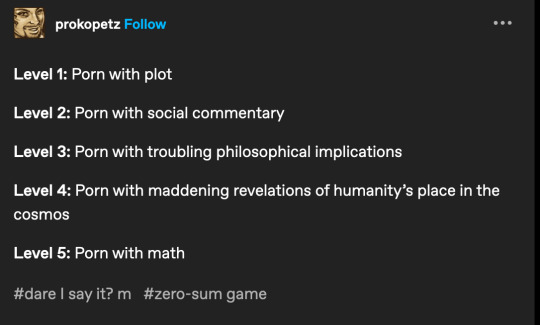
babes tell your friend they've reached Level 5 fic there ain't NO other bitches that are as mentally ill about making the physics of imaginary super powers work than ME
but also i love you thank you 😭😭😭 across fandoms too?! crying myself to sleep rn you're too wonderful
#on a funny/annoying note this chapter has the most comments of 'this made me (nearly) drop this fic...' than any other part#listen. LISTEN. i don't take it back. if you can't look at some fake-ass equations for 10 mins you dont love bkdk enough sorry#(i am... obviously joking)#also its technically physics. so. APPLIED math. which is cooler#and also. it was in no small part supposed to demonstrate how smart these two are#deku (d3ku) left katsuki that hint because he KNEW he'd figure it out#did i go overboard? perhaps. did it fuck severely? also yes#anyway i hope y'all know that that is my best attempt at legible handwriting#i wrote it on physical paper one million times before doing digital#spaceace i adore you why are you the sweetest#anyway tell your friend i'm sorry lmao#also i love physics i minored in it in college so i'm trying to get fucky with it in eih also#multiverse/timeskip plots are just RIFE for nerds#unfortunately quantum physics/mechanics is uhhhhh. well its not easy i fear
4 notes
·
View notes
Text
My stand on the Transgender Genocide
For the last week, I've been online, and researched, and warned, and read... All about two topics:
Cat Pictures - I just can't live without them.
Genocide - and about this I should continue writing this post. No more cat pics.
What's a genocide?, you may ask. Well, it is not necessarily systematic murder in camps of specific groups. It is any kind of an attempt to remove a group from society. It can be any kind of group:
Individuals of Species, a Sub-Species, or a Race within the Species
Individuals that carry a specific look, gene, or attribute
Believers of an ideology or religion
Basically, any kind of group. And no, it is not necessarily related to genes.
What's the problem with a genocide, then? If genocide means a removal of a certain group from society, what's the problem? If one honestly asks this question, they probably have been brainwashed at least once. And that's a completely different topic. I'll assume (and believe) genocide is bad for the entirety of the post.
What's the danger for us? For us, trans people - or any person - that is a huge danger. Genocide usually continues to murder, and usually doesn't stay restrained to a single group. The Nazis started with killing trans people, too. It means loss of our rights and our ownings - and later, our lives.
I accidentally deleted this paragraph. Oops. I'll rewrite it the best I can remember. I DELETED IT AGAIN I HATE MYSELF.
That won't happen to me. That's what the Jews thought pre-WW2. People really don't like their bubble being poken - the brain tries to protect itself, by the most valid strategy at the time - complete denial. No offense intended.
But the children! There are two responses to this sentence:
Your children will feel much safer being able to express themselves without crappy ideologies restraining them from doing so.
Children growing up in a place where rights are being taken from a group, will know very well not to join nor declare themselves a part of said group. That's just human survival instinct.
I deleted another paragraph accidentally. I hate myself so much. I'll just shorten it from ten sentences to one.
I'll stay and fight! Your choice. I'm a scared piece of crap, so I won't. Heavily unrecommended.
How can I flee? Here's something I wrote about that in a Reddit comment.
The Jews thought the same thing before WW2. They didn't believe the Nazis would murder them. They didn't want to run. Six million of them were wrong.
Run for your life. Now. Take all your assets. Cash only. Take digital stuff, and papers that prove you own something - but they'll be worth something only AFTER the genocide will end, so make sure you have physical valuable stuff. But the country CAN and WILL revoke your ownings. And not in USD - take it in another currency. You don't want your money not to be accepted because of sanctions, or the value of the money to drop because of a war.
You will want to move all the ownings you weren't able to take with you to the ownership of someone you trust, or to another country's banks (recommending the swiss).
Plan ahead. There'll be lots of refugees. The genocide won't stay restricted to only trans people. You will want to have valuable stuff to pay to people for food and a place to live in the country you'll be in. Secure a place to live.
And most importantly: flee. Tell all LGBTQIA+ people. Especially trans people. And don't say "I'm stealth", the government will seize your medical history and find out. The government will track you online. Don't say "it's illegal", because genocide is illegal, and they'll take any step possible to exterminate us.
Flee from the US. It's not about keeping those who will find out they're trans, and don't know yet - they'll grow up with enough internalized transphobia not to dare to say anything to anybody. It's not about a long term plan. This is about IMMEDIATE SURVIVAL.
Take a loan, to afford the tickets and housing in Europe or Canada or whatever place you wanna go to. It'll be invalidated when the law declares us inferior and non-human, when they'll forbid us from having bank accounts.
I'm NOT crazy. I'm Jewish, and German. My great grandfather was smart enough to run away, before he was murdered. His entire family - dead. This is a reboot of my culture and family's most remembered and important event. This, my friends, will be a holocaust.
They'll systematically murder and exterminate us. No remorse. They won't even see us as human beings. Flee the country. Please. Don't let hell collect another six million people.
And no, Hitler didn't go this far. He just said we're inferior, and should be murdered so "natural" selection will do its job. *They* are trying to finish Hitler's job. The monster that systematically murdered people, Jews, people of color, trans people, gays, intersex people, autistic people, and more and more - still has a legacy. We must run, and we must defend ourselves.
Canada seems like the best option - refugee status - but we know not if a genocide will be the only thing to happen. As far as we know, the USA could start WW3. After all, transphobia and racism commonly come together. If the republicans will win the elections - those who stayed are doomed. If the democrats win - it is only a delay, not a win.
Yeah, it's a bit fanatic. But it's written that way to scare people, make them actually think about it. I'm sorry, but I can't put a "read more" bar on mobile - I'll do it when I reach my PC. Thank you for reading this whole thing - and even if you don't agree, please reply!
31 notes
·
View notes
Text
So, I tried to calculate Control...
... and its Epic Games deal, with the help of my certified smooth brain™ and probably incorrect sources. I started this last night hella tired and with a headache, I have finished it up today hella tired and with a headache, and this is what I produced: bullshit! :D But hey, at least double checked bullshit that’s open for discussion and contribution and expansion. Also, I probably won’t list the sources because a) I’m lazy and b) I didn’t have to dig thaaat deep down to find all this so if you really wanna know you could probably hit google with it as well. Anyhow here we go lol So, the initial thought which got all of this rolling was the 2020-wrap-up-post Remedy linked on their twitter, and Epic’s linked publishing announcement in it: studios Remedy, Playdead and GenDesign will release their next next-gen games with Epic. Now, we all know Remedy are working on some sort of Alan Wake-ish thing as we speak (right? right?? god I hope so), which meanssss our boy will most likely be an Epic exclusive. Which makes me kinda sad because, well. I’m deep in Steam’s ass. Hell, I waited for Control for a full year before I played it because they can pry the Steam version from my cold dead hands. So I asked myself... was it worth it for them? How much money did they throw at Remedy (and 505 Games) to have them play along? Would they have reached more people from the get-go if they had released it on Steam right away? Did the individual programmer, designer, writer, artist, person behind it profit from this at all? (Also, like, about the rights and copyright thing,,,,, you’d think they could have learned from Alan Wake and its IP belonging to Microsoft and so not really being able to do anything more with it because they don’t ‘own’ it and shit) buuut anyway that’s not the point of this post, now it’s time to do some MATH BABEY
Ok, let’s start with some things we know. Facts. Figures. Data. Turns out my initial question, how much money was involved, could be answered by doing one (1) google search: according to Wikipedia, Epic gave Remedy and 505 Games €9.49mio. The total budget for the game was €26.9mio over the course of 3 years of development. We know that as of December 2020, over 2mio copies of the game were sold, with November 2020 being the best-selling month ever since its initial release in August 2019. This is where question 1) comes into play: how many of those 2 million copies were sold in 2019 and how many in 2020? Stay tuned, I think I found out.
We know that Remedy gets to keep 45% of the revenue, which, I assumed, means that 505 keeps the remaining 55% (probably a lot more going on there but shhh). We know that Control’s sales cooked up €17.84mio in 2019 (so months September – December), €17.7mio of those in the first month alone (O.O). Side note: because it came out at the very end of August, I’ll ignore that month and declare September the first sales month.
We know that 60% of sales in 2019 were digital ones (aka Epic Store, mostly), 40% physical ones (consoles PS4 and XB1), while in 2020, only 10% of sales were physical and a whopping 90% digital; which is people on Epic who wanted to get their hands on the first DLC and – you guessed it – the Steam release of the Ultimate Edition in August 2020.
Which begs question 2): what’s bigger, 60% of 2019 sales because ‘ooh shiny new game’, or 90% of 2020 sales because ‘yay steam release’? The answer may look obvious, but you have to take into account the dropping price, which I also researched for your pleasure and enjoyment.
For this I used a German website called idealo.de, which focuses on looking for the best deals for basically anything you can buy on the internet, and it also gives you diagrams that describe at which point in time the product was at which exact price. This is what it gave me: - release price: €60 - December 2019: €41 (PS4)/€44 (XB1) - mid-2020: €30 - Ultimate Edition release: €30 - December 2020: €14 (PS4)/€18 (XB1)/€30 (Ultimate Editions) At this point I was like “lol hold on i need chocolate for this cuz i’ll be here for some time *sweating*”
To continue this mess™, I see more questions: 3) How many employees does Remedy have, which positions do they work in and what are their salaries? 4) How many employees does 505 have, which positions and salaries do they have? 5) What’s the total revenue that Control has generated so far?
And also some more stuff like, are my numbers accurate, am I even grasping these concepts correctly, are there even more people involved or am I just trying to explain complete crap (yes) but let’s just ignore all of that shall we. At that point I went “oh shit what have i gotten myself into, this screen does not get my point across, i need pen and paper” and you know shit is gonna go DOWN when I do math on paper.
My paper math birthed the following calculation:
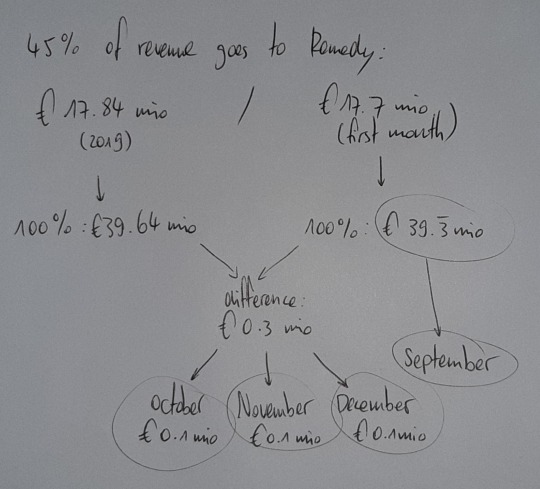
Following this up, we can calculate the end-of-2019 sales, if we set the price for September and October to €60, for November and December to approx. €45:
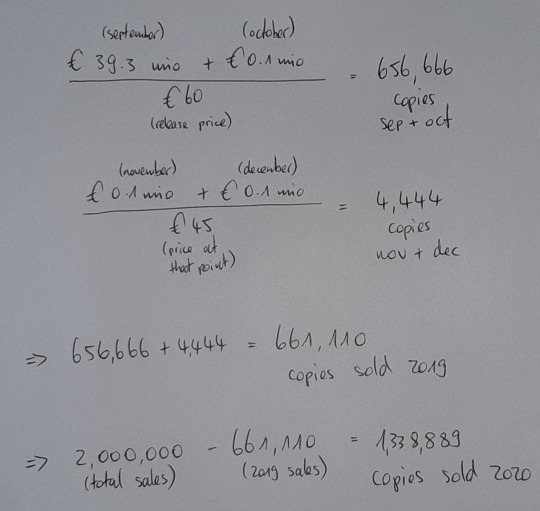
Now, you might notice that one of those numbers is big and the other is HUGE. Why might that be? Well...
- Covid19: everyone stayed at home and needed video games to play - More sale months of the year, naturally - dropping price: why get it for €60 when you can get it for 20 - Ultimate Edition: why buy it in June when you get more content in August aaaand... - it comes out on Steam.
With this in mind, let’s see what questions we can answer: 1) 661,110 copies in 2019; 1,338,889 copies in 2020 2) 60% digital sales in 2019 means 396,666 Epic copies; 90% digital sales in 2020 means 1,205,000 copies – most of it from Steam? Some of it? A good chunk? The bigger chunk? There’s no way of really knowing for sure but... you could read this into it. I definitely am. 3) Google told me Remedy had a little over 250 employees at the end of 2019... 4) ... and 505 has less than 100. I found no good sources for this, I think linkedin said 37, someone else said 50. I’ll just use the 50 figure, idk. No idea man. and for 5) I’ll contradict my point that the Steam release is what knocked the sales out of the park and assume that the number of sold copies stayed the same across all 12 months of 2020, which gives us this:

Ok and now we’re getting into the most dangerous of danger zones because I have no idea how companies or capitalism work, so for educated people™, the remaining calculations might read like a toddler wrote them; I apologize profusely and hereby present last night’s brain vomit:
As stated earlier, development took 3 years, but everyone wanted to get paid in 2020 as well so let’s use 4 years to find out the salaries, which is 48 months. Let’s assume the utopian idea that every employee on the line here gets the exact same amount of money (LOL ikr but shhhh, let’s live out our dirtiest equality fantasies for a second ( ͡° ͜ʖ ͡°)). Which would mean...

And now without the Epic Deal™:
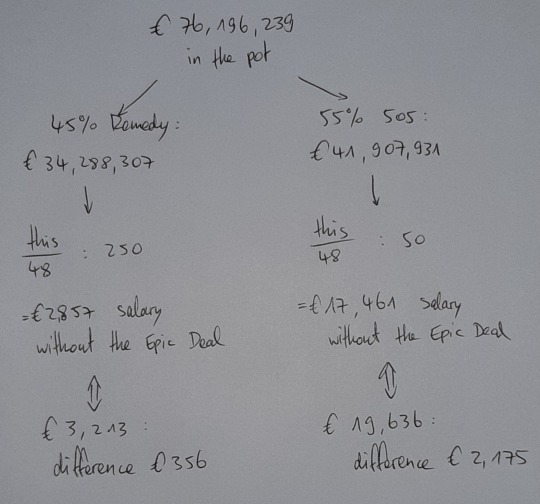
Quod erat demonstrandum. Remedy has been selling their souls to Epic for €350 a month since 2017. (I don’t mean this as maliciously as I’m making it sound, don’t worry xD)
OKAY SO, O B V I O U S L Y, I have not the slightest idea what on earth I’m talking about so read this like you’d read a good fanfiction. We don’t know the different salaries across the different positions (and genders HAH), we don’t know if other parties were involved, I’ve completely ignored the sum that Epic themselves get, I have ignored taxes, I don’t know if my numbers are accurate (they’re definitely not I mean 505 must have more employees than 50), if I made mistakes (yes), and also somewhere along the way I forgot to use the €26.9mio budget figure because, uuh, I have no idea where to use it, what it means, where did it come from, where did it go, cotton eye joe - but oh well, I’m not starting over, take it or leave it.
So... I can now officially say I have written hot steamy economics fic xD Man I put waaay too much time into this but damn was it fun. Good three-hour-deep-dive (two of them spent munching on chocolate half-asleep listening to psytrance to keep my brain twitchy). Real-life-theorizing. Fuck capitalism. Don’t do drugs. Pet a cat. Wear your mask. Call your grandparents.
If there’s typos in this I’m sorry but also I’m not, I can’t be bothered to proofread again lol. Goodnight imma catch up on the sleep I lost. Gotta love full moons
#this is the first post in ages in which i used punctuation and capitalization are you proud of me xD#dw it won’t stay like this#control#control remedy#alan wake#ok now go yell at me how stupidly wrong and dumb this is i’m ready#do you think my old math teacher would be proud#i think so#my economics teacher... not so much
8 notes
·
View notes
Photo
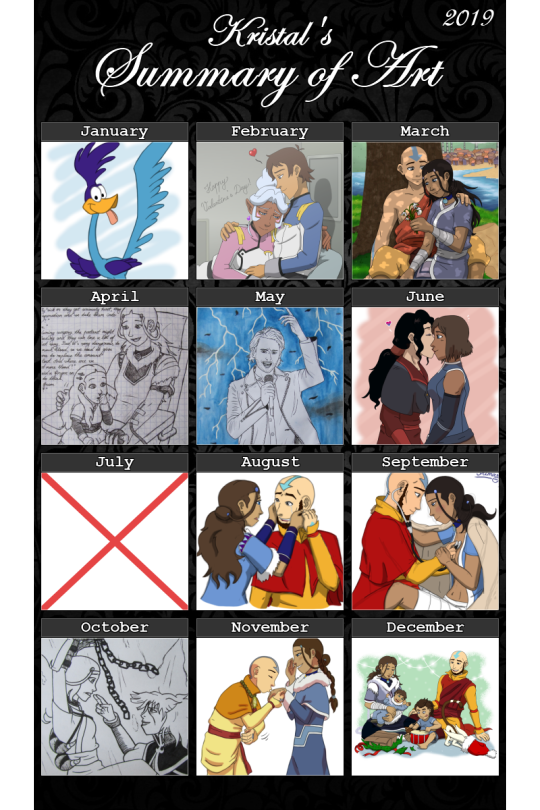
2016 | 2017 | 2018
*quietly sneaks back in*... Happy New THIS Year, my dear followers! In Estonia, we have this saying that if you wish someone a 'happy new year' after Three Kings' Day (the 6th of January), you gotta have a bottle of alcohol with you and give them a drink. *lol*
Anyways, I would like to apologize for the sudden disappearance that happened prior to Christmas. I was just busy travelling back home for the holidays, unpacking and putting away my stuff, watching some great, traditional movies or shows on TV, and most importantly, working on those 2 latest masterpieces that I posted (which barely got 30 notes each.. *sigh*).
But as you can (and probably will) see, the year of the yellow earth pig (i.e. my dad's year) was a rollercoaster of emotions and accomplishments, or lacking thereof.
My creative side seems to have suffered the most due to lack of leisure time. I only managed to finish 3 full digital drawings and left behind several sketches or unfinished WIPs (2 of which are revealed here under the months of June and November for the first time, I intend to finish the Korrasami one btw). At least I got to start 2020 with a completed drawing on the very 1st day, ha-ha! Perhaps that's a good omen for this year?
If so, then I hope I'll find the time to finish the rest of the 2019 Inktober prompts, since I only did 4/31 this past October (even though I'd thought of ideas for all of them). I brought all the necessary drawing utensils and sheets of paper with me, so whenever I'm in the mood, I'll try to sketch another one.
*calculates for the nth time*.. I wrote 18,110 words worth of fanfiction, plus 820 words for the UYLD prompts (making the total 18,930). Technically, you can count another 8k+ in there, since it comes from that unfinished story (of Aang taking care of a flu-ridden Katara, as illustrated by the September sketch), which I haven't finished within the last 4 months or so. Plus, I barely wrote 1/5 of the amount compared to 2018.. *hides in shame*
Then again, I was an excellent pupil for picking up an actual book and reading through 150+ pages (which means I have ~300 pages to go). I'm talking about the new Kyoshi novel that came out. As I once said, I haven't voluntarily read a book in years make that 2 years ago (most of the reading I've done in my life is either Tom & Jerry comics, now the Avatar comic trilogies and art books as well as fanfiction online, or compulsory reading during school). But this novel is freaking fantastic superb!
Not only that, I bought all the new comic trilogies and managed to read them through. Damn, did they give me feels.. especially "Ruins of the Empire" (ngl I squeed so hard when I saw the Korrasami farewell kiss on the 1st page of the 2nd part). I can't wait to read the 3rd part this year!
However, I failed to rewatch Avatar last year, and I haven't seen Korra since.. 2016, I believe? Wow, that's 4 whole years.. But I intend to fix that mistake starting from 2020. Hopefully I'm in the mood to start my rewatch this weekend tonight. *fingers crossed*
But as I said, I had much less time to focus on my hobbies since 2019 was the year for finally moving on with my life (sort of, I'm still working on it). I still remember how down I'd been feeling for a while and how valid those emotions really were. The first quarter of the year (+ like a month or two) was a continuous descent into desperation and feelings of utter failure, which already started around the 2nd half of 2018 and only continued to deepen around that time.
Everything began to change when I was first chosen to be part of a 2-month summer internship in an IT company, and I had to start building a new nest in a new location in Tallinn this May. And now, I feel like I've hit the jackpot by getting a permanent job in another IT company this October.
I got the opportunity to work in two different fields, in two different teams within a year. I met some awesome colleagues (a lot of whom are foreigners) and got the chance to really put my English skills to the test.
Thanks to the new job, I also had to go to a free health check, which went really-really well. Despite my nervousness in the beginning, I feel much more relaxed about my physical (and mental) health, cause the results showed that everything's okay (something I'd been worried about since March 2017).
Speaking of health or staying healthy, there were a few sports events that I went to, too. Our team held the first winter team event (it was the first one for me, at least) by going to do archery in a range on the outskirts of the capital.
I watched the football match between 2 teams of our local league at my hometown together with my dad on his birthday. Our home team won the match and came in 4th place overall in the league this year, which is their best result so far (I'm really proud!). And merely days before I started work, I visited the Tallinn International Horse Show for the first time (also with my dad). I last got to watch horses jump over fences or dance to their musical programs ~ 10 years ago, and I loved it!
Event-wise 2019 was pretty full of them. As has become tradition, I went to the Defence Forces parade on our 101st Independence Day (which seemed rather bleak compared to the centennial, even more so since we didn't have ANY snow at the time).
What will hopefully become new traditions, I visited the television tower on the Restoration of Independence Day (where Uku Suviste gave a free concert in the evening), and went to the Veteran's Rock concert (to honour our war veterans) on our Freedom Square on the 23rd of April (since I'm residing in the capital now, I should be able to go again this year).
To continue with the centennial celebrations (yes, some things are STILL turning 100), I saw and explored inside the armoured train no. 7 called "Wabadus" ("Freedom") in the Baltic Station. This armoured train was one of the keys that led our country to victory during the War of Independence from 1918-1920.
There was an even bigger (150th) anniversary to celebrate in the beginning of July, when I attended our Song and Dance Festival. This was a really important, if not the biggest event of the year. I intend to make a longer post about my experience, cause it's something that you foreigners need to see for yourself. I can't simply describe or put it into words, I have to show you some videos and photos.
But while we're on the topic of concerts, I should mention that I went to 2 more at the beginning of June - Bon Jovi and Sting - as well as 2 that were part of Christmas tours in December - Elina Nechayeva and Rolf Roosalu.
Besides that, I went to 6 different festivals, half of which I'd been to several times before, such as the Türi Flower Fair, Jäneda Farm Days (where I went on my first helicopter ride for my 25th birthday present) and the Christmas market in the Old Town of Tallinn.
The other half is comprised of festivals that I'd been considering going to for a while, or which took place for the first time. The latter applies to the Black Food Festival, whereas the "Valgus Kõnnib" ("Wandering Lights") and the duck rally, both of which took place in Kadriorg, fall under the first category.
The duck rally is a charity event held in the beginning of June. Regular people can buy at least one (or several) rubber bath duckies for different prices, which will then be dumped into a tiny stream that'll carry them towards the finish line. This event has grown more popular each year, and the money the Estonian Association of Parents of Children with Cancer (sorry, long name in English!) collects is donated to the Cancer Treatment Fund.
*wipes forehead*.. Phew! I'm surprised, that's a whole lotta positivity for 2019. I think there's one more important, but seriously negative topic I haven't covered yet, but I feel should be mentioned and explained.
When it comes to politics, 2019 was a complete disaster for us. EKRE (Eesti Konservatiivne Rahvaerakond in Estonian, or Estonia's Conservative People's Party in English) i.e. our populist/nazi/pro-Trump party is in the government as of April 2019, thanks to 100,000+ idiots (out of our population of 1.3 million) who voted for them and gave them 19/101 seats in the Parliament.
No, I am NOT going to apologize for calling them a nazi party, because their main leaders have repeatedly supported ideology that's common to nazis (they use aggressive rhetoric, blame the media for making them look bad, downgrade women, minorities, are racist, anti-semitic etc...). And I will not apologize in front of the people who voted for them, because "thanks" to this, EKRE has dragged our country's reputation straight through a mud puddle (not to mention the scandals that have accompanied 5 of their ministers, 3 of who have THANKFULLY stepped down from their positions) and.. *swears like the British*.. it's BLOODY EMBARRASSING.
I am done being nice, I have at least some kind of prejudice about anyone who supports them or their ideals. And I will certainly not let Estonia end up like America. So that is why I participated in two protest events against EKRE and our current government (because the 2 other parties, who were willing to form the coalition with them, are spineless jellyfish that simply seek to hold onto their current positions of power). I'm willing to take bets as to when our government falls (the sooner the better).
*shakes off the frustration*.. Brrr! So besides that, I guess the only downside to 2019 was my spare time falling back in the list of priorities (which shows in the empty square of July).
2020 is gonna be the year of the white metal rat. I can only hope (and take action so) that it'll be just as eventful, and much more creative than 2019. Thank you all for following me (or lurking anonymously) for so long, especially to the bloggers who've offered me support through better or worse! *raises a glass* Here's to 2020!.. *sip*
10 notes
·
View notes
Text
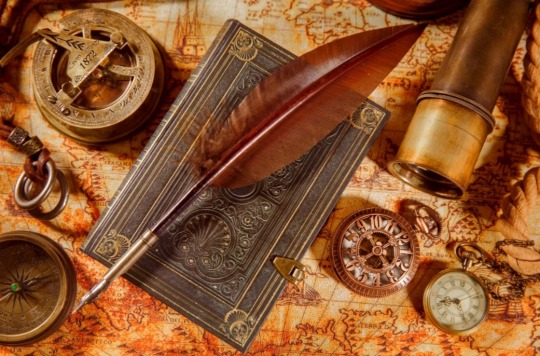
How to put 'It Works' to work for YOU!
The powerful idea presented so simply and well in 'It Works' will change your life. I know this because it has changed mine. The fantastic results that I have created using this idea have motivated me to investigate these principles for 25 years.
I want you to be rich with things that make you happy. I'm going to give you ideas and images you can use to help you be more successful with the list technique presented in 'It Works'.
What I have Done With 'It Works'
My annual income is now 35 times greater than it was the day I first read this little book. I have gained houses, cars, boats, businesses, friends, a family, and numerous creative and prospering ideas using the principles set forth in this book.
In the last 25 years I have spent thousands of hours teaching these ideas to other people. I've seen many people use the ideas in this book to create something new in their life, and I have seen others who are not so successful with it. I want you to be one of the successful ones.
How to Succeed with your List
First, let's take a little test. Take a sheet of paper (or your word processor) and without looking at the book write down the 'Three Positive Rules of Accomplishment' that are the key to this technique.
Then go back and compare them to the text. How did you do?
Did you miss a few? I did when I first tried this test myself.
If you read this book and it never goes farther than words and ideas in your mind, then you have lost the advantage of it.
The key to success with this method it to DO IT, not just think about it. Don??t think that by reading it, even many times, that you will know it. That would be like thinking that you know how to ride a bicycle just by reading about it. In order to master the bicycle, you have to get on it and ride, learning to keep your balance as you move forward. That is exactly the way you learn the principles of conscious creation taught by ??It Works??.
When I first started using the technique in this book, I wrote my first list, and started getting great results. Then after a month or so, I stopped writing and reviewing the list, and tried to 'do it in my head'. I didn't get the same results.
I went back to using the list, and the great results started happening again. Then I got what I wanted and let things slide, and the cycle repeated.
Meanwhile I started studying the ideas and teaching them to others. In the process I learned some interesting things I am sharing with you.
What I learned is that each of us has a spark from the Creator which is our own personal creator, like a genie from a magic lamp. The problem with this genie is that he responds to every thought in my mind as if it were a command. If I think of something with desire, he starts creating that for me. If I start to worry or fear, he starts to erase that creation.
Wherever I put my attention, the genie starts multiplying that attention into a real experience in my life. All of this creation takes place in a part of my mind called the subconscious mind. The subconscious mind is the part of my mind that holds the tremendous creative power that I can learn to tap into and use. However, it has a special way of working that I must understand if I want to use my subconscious mind power effectively.
If my attention wanders all over the place, my subconscious becomes full of half-created thought-forms and my life is chaotic or boring. That??s because the genie is busy trying to do a million different things at once, many of which contradict each other. His efforts always follow in the track of my attention, and until I get my attention going in a constant direction, I don??t get the results I would like.
The plan given in 'It Works' helps me to control my attention, and put that genie to work with enough time and focus to produce real and complete results. It will work the same way for you.
My conscious mind sets the agenda, but I often get distracted by the half-formed and malformed effects of previous wishes and desires. Many of those desires are unconscious, created with incomplete understanding or fear or worry. The genie does what I tell him, but he listens to my daydreams and worries and treats them as commands.
This creative power responds to what I believe. I have come to realize that what I believe is not necessarily the same as what I think. It's easy to know what I believe - it is what I act on. It is what I do. Even while I am unable to admit to myself what I really believe, my subconscious mind is working to make circumstances, opportunities, and events in my life to experience those beliefs.
How do I change what I believe, so that I can get what I want? There is a simple way to do this. It has been discovered and rediscovered by teachers and writers throughout the ages.
Here it is:
I can imagine what I want, I can pretend that it is so, and I can repeat this over and over.
The creative genie of my subconscious mind responds to imagination, focused attention, and repetition. That's what the book 'It Works' is all about.
How to Get Faster and Better Results
Here are things that will help you create more successfully when you use the technique presented in ??It Works??. These are things that I have discovered in the last 25 years of using 'It Works.' Each of these is a suggestion based on actual experiences with using the list. Use the ideas that sound good to you.
The most important thing is to do exactly what it says. Follow the plan exactly: Create a list, include what you really desire in order of its importance to you, read the list three times a day, think of the items on the list as often as you can, and don't tell anyone what you are doing.
For faster demonstration of results, you can rewrite the list each day, even if it hasn't changed. Reorder the items on the list according to their importance to you. Doing this makes the ideas new again, and will lead to more rapid success. It??s also important to do something physical with your ideas, as soon as possible. Writing them out is a way to give them entry into the outer world of manifestation. It creates a toehold for their growth into physical reality.
If you have a tape recorder, you can read the list out loud in a firm voice and tape it. Then play the tape over and over again (perhaps in your car as you commute to and from work). This needs to be done and played in private. That's easy nowadays since you can get an inexpensive tape player with headphones.
I found a little digital recorder that records into it's own computer memory, and then plays it back over and over again through headphones. You can also do this with the 'Sound Recorder' program that is built into most personal computers.
Put real amounts, specific items, and specific dates in your list. Some people worry that this is 'outlining' and delays manifestation. But what good is it to get Coke when you want Pepsi, or Pepsi when you want Coke? You don??t plant strawberries and expect to harvest watermelons. The most important thing is not a particular item on your list, but developing your power of conscious creation.
Do you have trouble remembering the items on your list? If so, it may be that they are not really that important to you. Try memorizing the items on your list.
Are you having trouble finding ten things to put on your list? Are you unsure which things should really be on the list? Here??s an easy way to build your list: ask yourself- ??What do I think about all day??? That is what should be on your list. You may have to start by listing your worries, and then turn each of them into a positive desire. For example, what do I worry about? What would need to happen for me to not worry about this any more?
If you have trouble finding things that you want, try thinking of it in another way. What would you like to see happen?
How will you know it is working?
When you receive an idea about something that is on your list, act on it in a positive way. Sometimes the thing you want requires a few intermediate steps. Be ready to go through several doorways as they open before you, to reach your goal. If you want a car, perhaps you will find yourself creating a new set of tires first, or a garage to keep the car in.
Realize that many of the things you want will find you. You will be tempted to say, 'but I didn't do anything, it just happened.' Your inner mind genie will use the simplest and most efficient way to create the results you imagine. It doesn't care who gets the credit. After a while you won't either!
Remember that your genie is working nonstop, according to the program that you set for him. If you say, ??this can??t be working??, he will do his best to make that seem true ?V even while he continues his nonstop creation of the other things you ask for.
How will you know it is working? For most people it is not one thing, or two things, but the fact that one thing after another manifests in their lives. The first thing you get from your list seems to be a coincidence, the second is luck, the third is serendipity, and the forth is a miracle. Finally after many creations, when your friends start wondering what the heck is going on, you will realize that there is a simple and rational law in operation, and that you know how to use it.
Get excited and enthusiastic about the good things coming into your life. If this doesn't seem natural to you, go ahead and use your 'power of pretend' to fake it until you make it. Appreciation is the oil of the engine of creation. Enthusiasm and excitement are manifestations of your appreciation, and confirmation of your positive expectation.
The attitudes that will delay your success or confuse your creation are jealousy, envy, resentment, reservations, uncertainty, and indecisiveness. Put all of those to the side. The more you recognize your own creative ability, the less you will care about those things that these attitudes have been attached to. You just won??t have time for those ways of thinking any more.
There is no such thing as a negative thought - every thought has a positive result in reproducing itself. Every thing you think about grows in your mind and becomes part of your physical life. That??s why it is so important to control what you are thinking. The key to controlling your mind is replacing the thoughts that create what you don't want, with the thoughts that create what you do want. You do not resist the old thoughts, you replace them by putting your attention somewhere else. Using your list is your key to accomplishing this. Use this physical tool to reinforce the thoughts that you want.
Think of your subconscious mind as being like a sailboat in the middle of the ocean. The sailboat is blown everywhere, back and forth, by the wind, which is the power of thought. It needs a keel and a rudder to be able to set a course and make way to a certain destination. Your list is the keel and the rudder of your subconscious sailboat.
Thought follows a certain structure in your mind. The idea comes first, then the belief, then the attitude, and then the behavior. Your strongest foundation, the anchor of your thinking, begins with your behavior. Change your behavior, then change the attitude that changing the behavior reveals, then change the belief that inspires the attitude. Grab hold of an idea that is bigger and more inclusive than the small ideas that have kept you poor and unhappy.
When you are tempted to tell everyone what you are doing to make the changes in your life, send them a copy of this book instead. After you have received 40 things you have asked for, you can start talking about the process you are using. Keep a list of everything you get until you receive 40 things you have asked for.
Many people find this book, and use it to get one important thing, and then abandon this method. How did this book come into your life? Your genie brought it to you, or brought you to it, in response to your conscious or unconscious desire to create a specific experience, or to understand creation itself. Take advantage of this experience, and make this intelligent, conscious creation a way of life, not a one-time experience.
??Hey Peter, get back in the boat!?? - the other 11 apostles
Trying to control other people and make decisions for them is a misuse of them, and of your own creative power. The most important thing you can make is a decision. Trying to take that opportunity for creation away from others is based on fear, not love. Fear in your mind will generally create things you do not want. Lewt people learn their lessons. God loves them, too.
I learned something wonderful long ago, that will give you freedom. I can??t prove anything to you about anything important or meaningful. However, I can tell you how you can experiment and prove these things to yourself. If I walked on water, you would be looking for the rocks. If you walk on water, you will know that there are no rocks. Using this list will show you how to walk on the water of your life. You will have to learn to politely ignore your friends as they yell: ??Hey Peter, get back in the boat!??
The Toyota Principle
The subconscious mind creation process goes on all the time. You don't have to be good to make it work. You don't have to chant, exercise, or repeat magic words. You are rich now with the results of what you have been thinking about. Your life is always full of something. If you want to be rich with something else, change what you are thinking about.
As you develop your ability to consciously direct your creation process, as you build your confidence and increase your will power, your results will come more quickly and be more satisfying. Don't delay this process by calling the results coincidence. Wait until you have received at least 40 items on your list (by receiving something and replacing the list item with a new item) before you judge the results as coincidence or creation.
You are already a success at creating what you are thinking about - everyone is. The biggest enemy of conscious control is self-importance - which may manifest in disguise as self-deprecation, worry about what others think of you, or the desire to have others approve of you. Don't let your ego distract your from taking control of your mind and your life.
Everything in your life is there because you have asked for it through either desire or fear. Nothing comes to you by itself. I call this the "Toyota Principle" because there used to be a commercial advertisement on television for a certain car company with the catchphrase "You asked for it - you got it - Toyota!' When you have used your list for a while, you will begin to see this is true, and then vast realms of possibility will open in your life.
It's a friendly universe.
If you are of a certain religious orientation, you might be concerned about this creative process and think it is a possible affront to God. I don't think it is. Think of the New Testament phrase, ??Pray without ceasing.?? I have decided that this is a description of what we all do all the time. We pray nonstop without knowing it. Practice of the method of conscious creation will show you what prayer is, how it works, and that it is always functioning. I am firmly convinced that learning how my mind works, and how to use it more effectively to help myself and others, is what God wants me to do. How about you?
You don't have to believe in God to use the list. However, don't be surprised if using the list shows you that there is order and structure to the universe, including your mind as a part of that universe. Your world is a lot closer to you and more responsive to you, than you may have considered it to be. It's a friendly universe.
Be careful about including other people on your list. If you want joy and happiness with Jane or Bill, is the joy and happiness more important, or the relationship with Jane or Bill? Maybe the best way to be happy with Jane is let her go find Bill, and let Suzy come find you. As long as you are focused on what someone can give to you, you aren??t yet completely experiencing love.
It may be tempting to think your success is dependent on the channel it happens to come through - your job, your family, a particular relationship or thing you possess. Time and experience will show you that this is not so. In the meantime, place your sense of appreciation and thankfulness on the Creator within you, who has made you in his image as a creator. When the river of your life changes its channel, you had better be ready to go with the flow.
How fast will it work? Faster than you will expect. I put the number one item on my list last week and it manifested in two days ?V and I thought it would be six months or maybe never. Fortunately, while writing and then rereading that list item, I suspended my disbelief. Even before your pen finishes the sentence, the act of creation has begun. Of course there is no magic in the pen or paper ?V the magic is in making the decision a physical thing instead of just a mental idea. No matter how long you use this method, there will be times when you are just utterly amazed at what ??happens?? to you. (It isn??t happening, you are creating it.) How fast can it happen? Don??t blink twice ?V you??ll miss it.
Everything you think will try to prove itself ?V including your skepticism. If you are afraid of what others will think of you, or of what you will think of yourself, then you may be fooling yourself while thinking you are being completely rational. The world is plastic to the molding power of your thoughts ?V even while you think this is untrue, or don??t have a thought about it at all. Everything lives and moves and has its being in a sea of self-modifying thought. You can prove this to yourself, and put it to effective use, with the simple experiment of work with the list for a few weeks or months.
It doesn't take much time or effort. You have nothing to lose. No one will even know you are doing it. They will just think that you have suddenly become incredibly lucky, intelligent, charming, and good looking. It helps to smile a lot.
Creating complete mind pictures is very helpful. That is another book in itself. Feeling joy and enthusiasm about your mental creation is very helpful. It will start to happen naturally as you use this process over and over, because ?{
It Works!.🏄♂️ ~Brad Jensen
1 note
·
View note
Note
Hi Ais! Sorry to bother you. I just need someone to talk to about this. I have been writing since i was like 15. My dream have always been to write a book. And i have started a lot of them but never finished anything. It’s like i get stuck at one point and feel my story is trash so i stop. Sometimes i find my plot boring and stupid and other times it’s my own inability to properly put it into words. I admire you and i wish i could write like you. I hope you never stop writing wonderful stories❤️
You’re so sweet, thank you!
I’m not sure if it would help to get a long ass rambling answer to this to encourage you to keep going based on my personal experience… but just in case it would, here goes:
It’s really hard to actually finish projects… starting them is so much easier. I get to a point where I’m like, “This is trash!” and/or I grow bored, and then I kind of peter out. I also have this unfortunate aspect of my personality where I figure I’m pretty unimportant and invisible, therefore what I have to say or write isn’t that particularly necessary for others to see, therefore it’s not that big of a deal if I just never post anything I did because I’d just be cluttering up the space where actual good writers or actual interesting people would be speaking instead.
Sometimes I just want to write a story to see where it goes, and then once I get to a point I can figure out how it will probably end, and if no one else is reading it or interested in it, I’m kind of like, well I know how it ends so I guess there’s no real point in writing the rest of it out or posting it because that’s just extra work for no reason. It was a combination of that thought process, and the feeling of “this is trash! Start over!” that had me writing and rewriting and dropping and restarting and editing and dropping and rewriting Incarnations since I was 12-14… I keep forgetting if I started at 12, 13, or 14 on that book. I think 14? But then maybe it was actually 13? idek.
Point being, that was a book that I started, stopped, started, stopped, dropped entirely, on and off for years. The idea would be really strong in my head but then sometimes I’d forget about it for years, then remember it for a while, then avoid it because I felt like a failure. What I know is when I first wrote it, I got 150 pages before I thought it was trash and totally stopped it. In the ensuing 15ish years, I would think of that world and want to do something in it but I just did not want to pick up where I had left off. So what I did was I kept starting new scenes, creating new characters, adding new aspects to the world, and each time I’d get a little ways into it and then go UGH THIS IS BORING or THIS IS TRASH and stop/drop it again, until the next time when I started something new again.
Around 2012, for Nanowrimo I tried starting it up again. I looked at the bits and pieces I’d written over the years, grabbed one of the scenes that seemed more interesting, started with that and ran with it. I met the requirements for nano, I liked the characters, I liked the new concept, but I still wasn’t sold on the book. I was kind of bored at the end of it because I didn’t fully know where I wanted to go with it… I was a little overwhelmed. It still didn’t really click with me to keep working on it again. I left it on the backburner for more years.
At one point, I created a Scrivener project for it, and then as the years passed and I’d get a brief idea for something, I’d go open it up and throw that info into a note, or add a new document exploring the idea, or whatever. Sometimes I’d write another short scene, other times I’d just do that and go.
Sometimes I tried to do other stuff related to it which was not writing the actual book… like I created some Sims to look like the characters, to see if I wanted to change anything in the description when I got an idea of it visually. Far more recently, I started making some of the key buildings in Sims so I could get inspired for more details on those. Are they accurate? Absolutely not. But they gave me ideas. Same as I tried to store the inspiration I’d get when watching tv shows or movies or whatever, and it would make me think of the characters or world or some other aspect. If I was inspired to write, I’d go write a note or scene right then, but if it was just a vague inspiration I would just try to focus on it when it was there, and really acknowledge the importance of feeling that inspiration, but then not actually do anything about it. But that would keep it in my mind.
Another thing I did when I really wanted to write was I would go to sleep thinking about an aspect of the story, to try to make myself dream something related, so I would wake up with inspiration.
I also tried to inspire myself by buying some physical organization materials – I got a bunch of whiteboards so I could figure things out by writing it out, and I got a huge roll of white butcher paper so I could hand draw massive timelines for the characters to lay out their events and see whose overlapped with whose; I got a corkboard and pinned index cards and sticky notes to it and then took different colored strings and connected them across the board according to various criteria. I got notebooks and wrote out ideas and notes on the magic system and all sorts of things. I had gotten to a point where I was glad to have all the digital information but sometimes I needed something physical to work on, something tangible, so I felt like I actually had accomplished something and it wasn’t just in my head. I also made a book cover for the book (digitally) to remind myself to keep working on it, and made a digital map of the world with the help of a friend who’s good with geology so I had a reference I could hang about my computer.
Every time I had a thought or idea, or I had this vague restlessness of wanting to work on something but not feeling like actually writing, I tried to do something else related to it in some form. Usually world building or character creation of some sort, but sometimes just thinking about things.
I tried a lot of things, but in all honesty I figured I would never, ever finish that story. But then one day, and I don’t even remember what the catalyst was to be honest, it just… clicked. I had an idea for something, and when I went to write down that idea or do whatever with it, I remembered other notes I’d left over the years, other scenes, and I started looking at the massive amount of information I had compiled - and I realized, holy shit, I know how to connect this all. I found a way to pull together a lot of stories I’d made which I thought were all totally disconnected, and bring them into one theme. And when I did that, all these questions I had for this or that aspect of this or that, suddenly had really interesting answers or ideas I could roll with.
I found a way to stop being bored. And now, when I find that I just really really don’t want to do the next thing, I try a few times to make myself do it if I’m just feeling like I’m being lazy, but if repeated attempts are unsuccessful then I throw myself a curveball in the story or plot or characters, and it becomes fun again to write and plot it out as I try to figure out how to integrate that. I do that until I run out of steam, and try the same things again.
Because of that, a couple of years ago, I finished the book, and I was really happy with it. I’m still proud of myself for finishing writing it, but now I’m on a two year slump of editing the damn thing.
When I think back to the original story I wrote when I was younger, versus the book it became now and the series it’s starting, they are VERY different despite the fact that have the same initial basis. In fact, the original heroine of the book is now technically sort of a villain. Her story is the same; I just flipped the perspective. The original book was very base; I mean, at the time, I felt it would be interesting to write because it was a young woman as the main character with all the power, at a time when almost all the main characters I found to read were young men.
But the thing is, it was otherwise a super basic concept. Young woman suddenly finds out she’s the chosen one, lots of cool magic, she goes through her whole storyline with how things affect the world around her, the end. The story might have worked and been interesting solely because I was like 14 when I wrote it; if it had been published then, people might have given me a bit of slack for some of the laziness just because I was young. But the story I have now, informed by decades of life and experience since then, is SO fucking much better than that book was originally. It’s way more complex, far more interesting, the worldbuilding is far beyond what I had before, the characters are more nuanced, the cast is more diverse, the prejudices are more tailored. I’m GLAD I put that book aside a million times. I’m GLAD I didn’t finish it any of the times I had it in my head I had to finish it by the time I was xyz age. I feel like the series it is now is going to be far beyond what it would have been if I’d run with the original idea.
You know what helped me A LOT in actually finishing it in the end? Aside from everything I said?
I asked some friends to beta read it for me. And the people who read it really liked it, and gave me ideas on how to improve it. Their interest renewed my own interest and gave me enthusiasm I sometimes lacked on my own. I care a hell of a lot more about actually finishing something if someone else cares if I finish it.
Someone once asked Neil Gaiman how to be a good writer and get published, and one of his biggest recommendations was to just finish writing a book. He also said not to conform; to write the story that you want to write, that is right for you. I feel the same way, which is nice because Neil Gaiman is super dope so I feel better that my feeling is reflected in an actual successful and great writer. I feel a little safer in having my weird ass view on things, which is that I don’t believe in genres, really, or rather I don’t really believe in writing a story specifically for the boxes checked off for a specific genre.
For me, anyway. It’s totally fine for others, if that’s their jam - there can be some great stories that way!
But for me, I literally just do not want to write a story at all if I have to make it fit someone else’s label. I lose all interest in it and give up completely. I think that’s probably because when I started writing, it was because I was a nerdy ass youngster who couldn’t find books that felt like they represented me exactly or what exactly I wanted to read, so I was kind of just like, “I guess I’ll write it, then.” There are tons of books out there that do fit the criteria of the genres, and they can be SUCH fun and good books to read… the people who write those books excel at that type of writing, and so if they tried doing anything else they would not be true to themselves.
We need those writers and we need those books. But we also need the writers and the books that just say fuck it to everything and do what they want. You may not be as popular, or you may find it difficult to go the traditional route; maybe you can’t become a full-time writer, if everything is stacked against you, I don’t know. But you can write what feels right for you, and there will always be readers out there who needed that book to feel right for them.
My hope for you is you don’t silence yourself and your stories like I tend to do. I hope you finish your books/stories, and I hope you share them. There is probably someone out there wishing your book existed, and until you write it, they won’t have that exact perspective and that exact story to read. Don’t get discouraged if it takes you a long time; and don’t downplay the value of walking away and not thinking about it for a while at a time. But I do think there’s definite value in always coming back.
So what I hope you do for yourself is find some easy way to compile all the different information you’ve formed for your book(s) over the years so that you make it really easy on yourself to add extra bits and pieces as you go. I hope that you do other things that aren’t specifically writing but still get your creativity going for the stories - whether that’s making Sims, drawing art, writing things out on paper or whiteboards, doing everything digitally, doing everything physically, whatever it may be. I hope you find ideally a few someones to read what you have so far, get their take on it, and I hope they are enthusiastic enough to help you keep it in the forefront of your mind.
I TOTALLY understand having wanted to be a writer since you were young… I have always wanted to be a writer, as far back as I can remember. (Of course, if you go back far enough, I also wanted to be a veterinarian or other things too).
My goal is still to someday be an actual author. I feel like I’m not, still, but maybe someday I will be.
I used to put a ton of pressure on myself to finish things by certain ages, and when I missed my goal I got depressed and thought I was the worst and why bother, no one wants to read it anyway, and etc etc etc. Also, for like 10 of those years I was working on ICoS and that really took my mental energy and creative interest as a focus so I didn’t really even want to work on my LGBTQIA+ fantasy books for a while. But as time passed, and objectively looking at the story I have now compared to the story it was before, I think it was far better that I didn’t force the story before I was ready to write it, but also that I didn’t let myself just put it off forever and never make myself work on it again.
There is no age limit to being a writer… first of all, you’re a writer if you write, so if you already wrote a bunch of books or parts of any stories - you are already a writer. You’ve already accomplished something awesome! But if your goal is to be a paid author/writer, then whether you are one now or one in 20 years or even 70, you still can be a writer. You still can fulfill that dream. Never give up on it, for yourself and for the diversity and complexity of the stories out there in the world, and for the readers who would want to see what you have to say.
Nanowrimo is next month… maybe you could start thinking about the stories you’ve worked on so far, see if any strike your fancy for exploring a bit further, or just take the general concept of one of the worlds and create a totally new set of characters and plotline on that world. Whether or not you end up liking that new plot, the new characters, it will still give you a more nuanced view of the world itself. It might spark an idea now or 20 years from now. It might, someday, be the key to finishing the story.
Don’t devalue the importance of those little bits and pieces, or the importance of taking your time but never giving up, or of even just talking the story out to others and seeing what they have to say. I constantly think what I write is boring and stupid, I constantly get suddenly bored with something and just cannot for the life of me write the next chapter no matter what because it sucks ass.
So I switch it up. I push aside for a moment what I thought I had to do next, and then I ask myself, “What can I add that would make me actually want to write this?” I’ve found that by doing that, you can get some super interesting new ideas that coordinate together out of nowhere later if you just keep going.
So maybe for nano, you can ask yourself, “What would I want to write in this world or this character’s life, etc, that would make me actually want to write it?” Completely forget about it fitting perfectly with what you have. Screw that. Just make it fun for you. I feel like it’s a very natural writer thing to do where even if you start with something that seems extremely disparate, as long as they’re following the same general world rules, eventually you’ll have an epiphany that ties it all together.
Also ask yourself, are you trying to make the characters conform to the plot, or letting the plot conform to the characters? If your world or characters want to veer totally off from what was planned, as long as it’s in character - follow them, not your plans. You wrote those plans when you had a limited understanding of the characters and world… the time you spent with them since then is valuable and shouldn’t be ignored. If they want to send you on a wild goose chase into the middle of nowhere when they’re supposed to be doing something else entirely, do it. Follow that goose. See where it leads you, and then see how fun it is trying to make your way back.
Maybe you can try that this nano (or just do a totally new story altogether if that’s your jam instead), and see where it takes you. Maybe you can find some people to read it, and maybe you can track all the info you put together, no matter how small and stupid it may seem. And maybe, someday, you’ll be able to look back years later like me, and thank your past self for never giving up and for keeping that information accessible so that one day, far down the line, you’d have everything you needed at your fingertips when a sudden idea inspires you to look at your story, characters, or world, from an angle you’d never considered before.
Also, fwiw, I like to always throw one thing in that’s a bit unexpected, if possible, into characters or plots. In all honesty, I do that in part because I get bored affffff very easily so I want to keep myself entertained. But it also makes for a lot more interest, I think, in the characters. Like, whatever the plot is, or the character is, think about what would be the easy next thing… think about what the stereotype of that would be. And then deliberately choose something either completely different or a little bit off in order to introduce intrigue.
ICoS, for example - Boyd was judged a lot for many things, and he wasn’t really good around people naturally. It would have been easy to say that because he was kind of socially distant/awkward he would suck at undercover, but to me that wasn’t interesting. Instead, he could go undercover and be very good at it when needed because, despite his natural reticence to trust others, he had spent his life watching other people trying to learn their behavior/mimic them to understand why people didn’t like him. So even though on his own he would hate going into a party or have no fucking clue what to say, if he was playing a character, he was very good at it because he had gathered that information for years. Instead of saying that because he was bullied he didn’t know how to deal with people, I said he knew how to deal with people because he was bullied.
Incarnations, for example - Vikenti is a magical cop who’s really grouchy, kind of rude, kind of a dick. He spends most of his time seemingly insulting everyone around him. It would have been easy to just make him be a dick cop who grumps on everyone and does nothing beyond the job. And yet, he’s taken under his wing a young woman who others see as a monster. A young woman who everyone who knows the story of their background would think he would have every reason to hate. And you also see him helping this random girl get a memento even though he easily could have ignored it because, ultimately, she had nothing to do with him. There’s also an Empath who’s a pretty good dude who has the biggest crush on him even though their sexual orientations don’t line up. Everyone wonders how this Empath can even like him when he’s such an asshole, but then you have to ask yourself, wouldn’t an Empath of all people know best who to trust and who not? There are scenes with Vikenti, who seems like a super straight and straight-laced dude who doesn’t know how to explore emotions beyond insulting people, where he is the one there who catches someone when they fall, or says just the right thing when it’s needed. Because he’s an asshole, but not an asshole. He cares but just doesn’t care.
So, if you’re bored with parts of your stories or characters, I also really encourage throwing dichotomy and contradictions in there. Take something solid on the story, and then think of something that seems to be at odds with that, and make that be a solid part of it too. Now you have something interesting to explore… how someone or something can be these two seemingly contradictory things in the same form. I find that can help me stay interested, too.
Anyway, I’ve rambled enough and am probably not very helpful, I’m sorry :( I just wanted you to know I totally know what you mean, and precisely because of that, I know without a doubt you can do this. You will finish the story or stories you need to finish. I 100% believe in you, and I hope you can get to a point where you 100% believe in yourself too.
Happy writing, my friend! You are going to finish your stories and they’re going to be fantastic! And if they aren’t fantastic the first draft, that’s the way it is for pretty much everyone - all you have to do is keep working on them until they are. You will absolutely get there, because it’s a journey you already started long ago. You’ve come this far and there’s a lot more waiting for you as you go forward. My writing voice is no better or worse than anyone else’s, it’s just what feels right for me. Your writing voice is yours and therefore inherently lovely. Which means, if you wish you could write like me, you absolutely can: by writing like yourself. I bet you already are, you just can’t see it because of how stressful it can be in the middle of the millionth project feeling like you got nowhere previously. But if you keep going, keep pushing, I know you won’t regret it later, and I know the story you end up finishing will be exactly the story you needed to write at that time, and somewhere out there in this world, someone will be incredibly grateful to you for having written and shared it.
(Oh btw the thing I was talking about is Incarnations - and the first 4 chapters are out free here if you want context on the stuff I mentioned, in case somehow it helps? I really need to edit it… I keep putting it off, but your message is making me want to start it up again, so thank you!
#ask ais#writing#incarnations#wildwood rising#I talk a little about icos but feel like I shouldn't tag that?#idk#anyway the tl;dr on this is you can totally do it!#i believe in you! :D#Anonymous
14 notes
·
View notes
Text
The Good Thing That Came Out of the COVID-19 Pandemic

Dear Readers,
As you know, it has been a really tough 2020 so far, worldwide.
Here in the U.S. we’re still battling COVID-19; dealing with hurricanes, social unrest from racial conflict; a very divisive political situation, and here in California where I live, forest fires (about 400 burning at the same time at one point) enough to cause air quality warnings far away from the fires.
I know some of you are in Europe, Asia, Australia and the Middle East. I hope things aren’t so bad over there.
But enough of that. We must focus on living and make necessary adjustments to carry on with our lives.
There is an old Chinese saying that goes something like this: From crisis, there is opportunity (forgive me if I butchered it; no insult intended).
For the COVID pandemic, this turned out to be true: millions, if not billions of people all over the world learned that they could do a lot of things that they normally did in person, online. And for those who already did this well before COVID, they learned how to do it even better.
Shopping, buying groceries and sundries, attending school, working, holding meetings, attending church services, getting music lessons, and socializing are just some of the activities people learned how to effectively do online, thanks to being quarantined.
And, in my opinion, the most significant thing people are doing more of online, thanks to COVID: healthcare. Telemedicine, also called telehealth involves using a telephone and/or webcam to communicate with a health professional instead of in person, face-to-face for the purpose of improving one’s health. It also encompasses “consuming” health care content in digital format via the internet such as pre-recorded videos, slides, images, flow charts, white papers, and audio files and podcasts. I wrote about this over five years ago when I decided to transition my practice to a telehealth model.
Telehealth was just starting to gain traction right before COVID, but the pandemic accelerated its acceptance. The need to quarantine and social distance forced doctors and their patients to interact online, and things will never be the same (in a good way). We were hesitating at the edge of the swimming pool and COVID pushed us into that cold water, figuratively speaking.
Webcams, Internet, Wireless Connectivity and Mobile Devices Finally Transform Healthcare
The “planets aligned” for telemedicine, and very soon it’s going to be as common as buying groceries. To me, it’s overdue. I hope that telehealth not only enables healthcare for millions more lives on the planet, it will drive healthcare costs down. The cost savings to hospitals are obvious; and those savings should be passed on to the insured and paying patients. We’ll see if that happens. While I know people are used to tradition, starting from the days of the old country doctor with good bedside manners I think in 2020 and beyond, people are going to be just fine seeing their doctor online for simple and routine visits.
And the implications go beyond the actual care: telemedicine will save time and money on a macroeconomic scale, and will be actually good for the environment in more ways than one: less cars on the road (no need to drive to see your doctor); less electricity and other overhead expenses needed to keep a large building operable, less printed paper, etc.
Telehealth Is Ideal for your Average Doctor Visit
The vast majority of things that cause people to seek a doctor are non-emergency, and lifestyle related. Non-emergency means not life-threatening, or risk of serious injury. Lifestyle related means conditions that are largely borne out of lifestyle choices—high-calorie/ junk food diets; alcohol use, smoking, inadequate exercise, occupational/work-related, etc. and are usually chronic; i.e. having a long history–diabetes, high blood pressure, indigestion, arthritis, joint pain, etc. These conditions can be self-managed with proper medical guidance provided remotely via webcam. I believe that if lifestyle choices can cause illness, different lifestyle choices can reverse or minimize those same illnesses, which can be taught via telehealth.
Then there are the cases that are non-emergency, single incident: fevers, rashes, stomach aches, allergies, minor cuts and scrapes, and things of that nature. Sure, some cases of stomach aches and headaches can actually be something dire like cancer. But doctors know that such “red flag” scenarios are comparatively rare, as in less than one percent of all cases; therefore, the vast majority of them can be handled via telehealth. Besides, the doctor can decide at the initial telehealth session if the patient should come in the office, if he/she suspects a red flag.
A Typical In-Office Doctor Visit
Typically when you go to a doctor/ primary care physician, you are given a list of disorders and told to check off any that apply to you recently—stomach pain, headaches, vomiting, fever, etc.
Then, you are asked a bunch of questions related to your complaint. This is called taking your history (of your condition). The nurse practitioner or doctor may do this.
The doctor may or may not examine you, such as checking your eyes, ears, nose, and mouth; temperature, blood pressure, heart rate, lungs and so on depending on your history and complaint.
The doctor then takes this information and comes up with a diagnosis or two. You may be referred for diagnostic testing, again depending on what you came in for, such as an X-ray, MRI, ultrasound or blood test.
You may get a prescription for medications or medical device, and a printout of home care instructions, and then you’re done with your office visit.
With the exception of a physical examination involving touching and diagnostic tests, everything I just explained can be done via a telehealth visit on your computer. But as technology advances, more and more medical procedures will be performed remotely via a secure internet connection.
I believe that in the very near future, there will be apps and computer peripherals capable of doing diagnostic tests which will allow your doctor to get real-time diagnostic data during your telehealth visit. It’s already possible for blood sugar, body temperature, heart and lung auscultation and blood pressure.
Imagine wearing gloves with special, embedded sensors in the fingertips that transfer sensory information via the internet to “receiver” gloves that your doctor wears, 20 miles away. During a telehealth visit, you can palpate (feel) your glands, abdomen, lymph nodes, etc. and this sensory information is immediately felt by your doctor, as though he was right there palpating and examining you.
Or, imagine an ultrasound device that plugs into your HD port that transfers images of your thyroid to your doctor via the internet.
The possibilities are endless, and it bodes well for global health. Imagine all the people who can be helped, all over the world, via telehealth. It’s truly an exciting time in healthcare.
Telemedicine for Muscle and Joint Pain and Injuries
Every day, millions of people worldwide sustain or develop some sort of musculoskeletal (affecting muscles, joints, tendons, ligaments, bone) pain, whether it’s their low back, neck, shoulder, hip, knee, hand or other body part. If not treated right, it can become permanent or chronic.
Chronic pain, and even acute (recent onset) musculoskeletal pain can effectively be addressed via telehealth (this is the domain of my platform, Pain and Injury Doctor, and it’s my goal to help a million people worldwide eliminate their pain).
Available medical procedures for musculoskeletal conditions requiring an in-office visit such as surgery and cortisone injection are usually not the first intervention choice for such pain. Conservative care is the standard of care for the vast majority of non-emergency musculoskeletal pain and injury–an ideal application for telehealth.
For example, if you were to go to your doctor for sudden onset low back pain, you would most likely be given a prescription for anti-inflammatory medications, if not advised to just take over-the-counter NSAIDs such as Motrin, and rest. You would also be given a printout of home care instructions, such as applying ice every two hours; avoiding heavy lifting and certain body positions; and doing certain stretches and exercises. As you can imagine, such an office visit could easily be accomplished via a telehealth session. No need to drive yourself to the doctor’s office for this.
But what about chiropractic or physical therapy? You can’t get these physical treatments through your webcam. Yes, chiropractic has been shown to be effective for acute and chronic low back pain, but available studies typically don’t conclude that chiropractic for low back pain is superior or more economical than exercise instruction or traditional medical care. Same with physical therapy. However, as a “biased” chiropractor myself, I believe the benefit of spinal adjustments is not just pain relief, but improved soft tissue healing and structural alignment; two things that I believe can help reduce the chance of flare ups/ chronicity.
So get a couple of chiropractic adjustments if you can, but know that you can overcome typical back pain through self-rehabilitation as well (see my video on how to treat low back pain).

Many Types of Pain Can Be Self-Cured
Take a second to look at my logo. It looks like a red cross, but it’s actually four converging red arrows that form a figure of a person showing vitality, with arms and legs apart. The four arrows represent four pillars of self-care that my platform, The Pain and Injury Doctor, centers on:
Lifestyle modification (nutrition, mindset, healthy habits)
Using select home therapy equipment
Rehabilitative exercises
Manual therapy
These are four things that people suffering from pain are capable of doing by themselves, and sometimes with the help of a partner (manual therapy). All of the Self Treatment Videos on Pain and Injury Doctor incorporate these four elements of self-care (some are still being produced as of this writing). Isn’t this more interesting than a bottle of Motrin?
Conclusion
I will close with this: research shows that when patients are actively engaged in their healthcare, they tend to experience better health outcomes and it’s not hard to figure out why. By participating in your own health, you have ��skin in the game;” i.e. you are invested in your health rather than being passive and wanting health to be “given” to you by a doctor through medicine or treatments. Mindset is what drives behavior, and those who are passive about their health are the ones who pay no attention until it’s too late—they don’t eat healthy; they don’t exercise enough; they voluntarily ingest toxins (junk food, alcohol, and smoking) and engage in health-risky behaviors. For many health conditions, by the time the primary symptom is noticeable, the disease has already set in; for example, onset of bone pain from metastasized cancer; or the first sign of pain and stiffness from knee osteoarthritis.
Being actively engaged and invested in one’s health will pay huge dividends in one’s quality of life, and longevity. So, in order for telemedicine/ telehealth to work for you, you need to have this mindset. You have to “do the work.” I can show you clinically proven self-treatment techniques to treat common neck pain, but they obviously won’t work if you don’t do them, and do them diligently.
Self-care for managing musculoskeletal pain is a natural fit for the telemedicine model of health care, which made its world debut this year. I’m excited to produce content that can help you defeat pain, without visiting a doctor’s office. I’m especially excited if your are one of the millions of people who don’t have health insurance or access to a health professional, and I am able to help improve your quality of life by showing you how to self-manage your pain.
If there is anyone you know who can benefit from this site, please share. Take care.
Dr. P
0 notes
Text
Prison Mail Surveillance Company Keeps Tabs On Those On the Outside, Too
In March 2018, the Virginia Department of Corrections (VA DOC) was trying to gain more control over the mail its approximately 30,000 incarcerated people received. Mainly, it wanted to close a loophole in which people posed as businesses so they could include color photos. A contact at the Pennsylvania Department of Corrections recommended they talk to a Florida company called Smart Communications about its product, MailGuard.
Smart Communications offered to do a whole lot more than that. It offered VA DOC a suite of products that would make it possible for prison officials to monitor and search all inmate communications with the outside world. It would create a searchable database of everything each prisoner said and received, along with who said it. And, the company claimed, it would include postal mail in this dragnet through its MailGuard product, by scanning each mail item at a remote facility and uploading PDFs for incarcerated people to view from a tablet. The people in prisons would never receive the physical letter.
The MailGuard system works by having senders address their mail not to the prison, but to a PO box rented by Smart Communications. For state DOCs, the company offers to set up a mail receiving facility in the state, and then ship the mail to its Florida facility for processing. There, the mail is opened, scanned, and uploaded. According to the proposal, inmates would then log into a kiosk to view the PDFs of their mail remotely. After 30 days, the mail is destroyed. There is no way for incarcerated people to ever physically hold or recover their mail.
And, the company said, it would not only track incarcerated people inside the walls, but their friends, family, and anyone who sent mail to them, too.
"Investigators will have access to the postal mail sender’s Email address, physical address, IP Address, mobile cell number, GEO GPS location tracking, exact devices used when accessing system [sic], any related accounts the sender may also make or use," Smart Communications said in a proposal for VA DOC. The proposal and other documents were obtained through a public records request.
Motherboard is posting the proposal, which was created specifically for the VA DOC, because it shows how a private company proposed a complex surveillance system that would keep tabs not just on incarcerated people but also on the people who sent mail to them, even if they were not suspected of a crime.
This system, Smart Communications boasted, "eliminates anonymity of postal mail, now postal mail has a digital fingerprint with new intelligence." And this intelligence could be used to crack down on "gang members."
When Motherboard asked Smart Communications for comment on this article, a lawyer for the company demanded that we not publish any of the documents, which were obtained using freedom of information laws that journalists regularly use to procure public documents about how taxpayer money is being spent and the general dealings of a democratic government.
"I understand you have obtained information relating to a confidential proposal that Smart Communications previously made to the Commonwealth of Virginia Department of Corrections. Please be advised that this proposal and the information therein was provided pursuant to a confidentiality understanding / NDA and was clearly and prominently designated as CONFIDENTIAL, PROPRIETARY, and TRADE SECRET," David Gann, general counsel with Smart Communications wrote in an email. "It should never have been shared with you or anyone else by the recipient. We will deal with that issue separately, but regardless, Smart Communications demands that you, Vice Media, Motherboard, and any other affiliated companies or entities immediately cease and desist all efforts to further disseminate or distribute any information obtained in that confidential proposal. Smart Communications further demands that you immediately destroy all copies of its proposal."
In its FOI response, the VA DOC claimed that it did not have any nondisclosure agreement with Smart Communications. The documents obtained as part of this request were automatically made available through Muckrock, the nonprofit platform Motherboard used to file the request on. Motherboard has redacted some inmate personal information and personal contact information for Smart Communications executives.
"Smart Communications takes the protection of its intellectual property and confidential / trade secret information very seriously, and it will pursue all violations to the fullest extent of the law," Gann continued. "Please immediately confirm receipt of this email, that you will not further violate Smart Communications' intellectual property rights by publishing any aspect of its confidential proposal, and that you have destroyed all copies of Smart Communications' confidential material."
The proposal, which VA DOC did not ultimately pursue, does not explain in detail how Smart Communications' platform works, it generally lists its capabilities and prices. VA DOC opted to spend about $7 million a year on an in-house solution of photocopying and shredding all mail before delivering the copied version to people in prison. But Pennsylvania did sign a contract with Smart Communications, through an emergency procurement process, due to a controversial and contested claim of a surge in mail being laced with synthetic marijuana.
The rollout was "a mess," according to Quinn Cozzens, staff attorney at the Pittsburgh-based Abolitionist Law Center, a public interest law firm.
"Mail was delayed for weeks or months and was regularly delivered to the wrong person. Color photos were scanned and delivered in black and white, often with portions of the picture cut off. They rejected mail and returned it to the sender without explanation for why it was rejected." Plus, the promised kiosks never materialized, as PA DOC staff printed out the PDFs on copy paper and handed them to incarcerated people just like VA DOC does.
While Pennsylvania's deal with Smart Communications was widely reported at the time, the extent of the company's capability to track people not in prison has not been previously known.
"Smart Communications has been boasting of their dystopian surveillance system at least since they were awarded a contract by the Pennsylvania Department of Corrections in 2018," said Cozzens. "Smart Communications’ total surveillance of every aspect of communications with incarcerated people is a chilling convergence of the expansion and privatization of the surveillance state on one hand, and a growing private industry that profits from holding human beings in cages on the other."
The extent of Smart Communications' reach across the U.S. mass incarceration landscape is not yet known. In communications with the Nebraska Department of Corrections in October 2018, which Motherboard also obtained via a public records request, a company representative boasted of its contract with Pennsylvania and claimed to be "under contract negotiations with Virginia, Georgia, South Carolina, Tennessee, Maryland, Utah, and Florida!"
At least in Virginia's case, this was a bit of an exaggeration, as Virginia received a proposal but never pursued it. The majority of the company's clients appear to be regional and county prisons.

Screenshot: Virginia Department of Corrections documents
"Written correspondence is one of the most, if not the most, important means for incarcerated people to maintain connections with family and loved ones outside of prison," Cozzens said. "Smart Communications prevents incarcerated people from ever holding a drawing sent to them by their child, or an original photograph, or a handwritten letter from a loved one that hasn’t been scanned and reprinted on a sheet of copier paper."
In the proposal, Smart Communications estimated it would pocket $1.8 million in profits over a five-year period through payments from VA DOC for equipment and maintenance. At least in PA DOC's case, incarcerated people do not have to pay to access their mail, although Smart Communications told VA DOC that if it opted for its digital communications suite, people sending messages to people in prisons would have to pay 50 cents a message or $1 a photo.
Smart Communications offered VA DOC a system to monitor, approve, and potentially reject mail using a "management console" giving them "instant access to the entire VADOC database of inmate mail." Investigators can receive real-time alerts via text or email when an inmate marked as a gang member or otherwise flagged receives an item of mail.

Letters can be approved or rejected by DOC staff. Screenshot: Virginia Dept of Corrections
The company further offered VA DOC the "Smart Tracker" system, the one that tracks the people who send incarcerated people mail. The proposal doesn't detail how the system works, but it appears to use the data people input to create an account through the "Smart Jail Mail" portal to connect them to the letters they send. The company retains all digital copies of mail for seven years, meaning if the system is used in enough prison systems, over time it could generate a considerable database about who associates with whom.
This creates real privacy concerns for people whose only "crime" is trying to communicate with someone in prison, says Aaron Mackey, a staff attorney at the Electronic Frontier Foundation who has worked on prisoner privacy issues.
"People who communicate with prisoners are now going to have reduced autonomy, privacy and expression and associational rights," Mackey said, "because now, wholly innocent individuals who are trying to just communicate with family and loved ones, members of their community and so on, are now going to be caught up in this surveillance." Even institutions like social service organizations and religious leaders will be caught up in the dragnet, Mackey warned, potentially getting flagged as troublesome figures because they communicate with people in prisons.
But the most significant issue, both Mackey and Cozzens say, is the emotional toll not receiving physical mail takes on incarcerated people. Even before the pandemic, many prisons have gradually shifted to encourage mostly digital interactions through video visitation and similar efforts. Physical mail was a key link between people in prison and their support networks. That link is being cut.
To be sure, people in prison do not have a reasonable expectation of privacy even for physical mail. Prior to the Smart Communications contract, all postal mail in Pennsylvania state prisons was opened and physically inspected for contraband by prison staff and skimmed for contents, Cozzens said. But it was rarely scanned and preserved. Once the initial inspection was complete, the mail was delivered to the person it was addressed to.
Cozzens sees a huge difference between that approach and what Smart Communications is doing. "There is quite a difference between a prison guard potentially skimming over a letter one time before delivering it, and every person who sends mail to an incarcerated person having their letters scanned, rendered digitally searchable, stored for seven years, and on top of that their personal information is also stored and meticulously tracked." He compared it to police agencies merely writing down a license plate when they pull someone over versus deploying license plate readers on a mass scale.
"This is just another step down that road," Mackey said, "where prisoners increasingly have diminished rights and privacy."
Prison Mail Surveillance Company Keeps Tabs On Those On the Outside, Too syndicated from https://triviaqaweb.wordpress.com/feed/
0 notes
Link
Beeple Brings Crypto to Christie’s Mike Winkelmann never used to call himself an artist. But that was before he made $3.5 million in a single weekend from selling his artworks. In December, he auctioned off multiple editions of three digital artworks, each priced at $969, and 21 unique works, most of which sold for about $100,000 each. It was only the second time he had put his art on sale. The digital artist, who goes by Beeple, has created a drawing every single day for the last 13 years. He started with pen and paper but now mostly uses computer software such as the program Cinema 4D. On Thursday, a two-week-long online auction of a composite of the first 5,000 days of the project will begin at Christie’s, which says it’s the auction house’s first sale of a solely digital artwork. It will also be the first time that Christie’s will accept payment in the cryptocurrency Ether. Beeple is selling these works as NFTs — nonfungible tokens — digital collectibles that use blockchain technology as authentication. An NFT can take any form, but for Beeple, it usually consists of an image or video file, sometimes with a physical object attached, verified with a digital signature on a blockchain. NFTs cleverly respond to the art world’s need for authentication and provenance in an increasingly digital world, permanently linking a digital file to its creator. It makes digital artworks unique, and therefore, sellable. The speculative market for NFTs has skyrocketed in the last 12 months, and continues to grow. According to the NFT Report 2020, published by L’Atelier BNP Paribas and Nonfungible.com, the value of the NFT market tripled in 2020, putting its current value over $250 million. Now, the same investors who speculate on cryptocurrencies are trading wildly increasing volumes of NFTs on websites such as MakersPlace (which is partnering with Christie’s for the Beeple sale), SuperRare, and Rarible, where recent transactions are front and center. Memes and graphic collectibles are sold alongside artworks like Beeple’s, blurring the line between them. Although it’s the first time that Christie’s will sell a purely virtual work, the art world is familiar with this genre of sale. To take one example, anyone could duct tape a banana to the wall, but it wouldn’t be Maurizio Cattelan’s “Comedian.” Likewise, someone could easily make a digital copy of Beeple’s “Everydays — The First 5000 Days,” but even though the content would be exactly the same, they wouldn’t own the artwork itself without blockchain verification. NFTs make it possible to collect digital artworks in a similar way to paintings, sculptures or conceptual artwork. “I don’t know anything about the traditional art world,” said Beeple, a computer science graduate, who only began researching NFTs in mid-October. Though he was a newcomer to both fine art and crypto-art, his “Everydays” project, now 13 years in, has become popular online. He’s amassed a huge following (nearly two million on Instagram, 200,000 on Twitter) with his apocalyptic, warped aesthetic leading to commissions from brands such as Louis Vuitton, whose Spring 2019 collection was emblazoned with his images. Beeple’s work has a brash, in-your-face appeal, like a political sketch cartoon set in a dystopian video game. Politicians like Donald J. Trump, Kim Jong-un and Hillary Clinton feature (often nude with mutant, robot bodies), as do Buzz Lightyear, Mickey Mouse and Pikachu. Since Winkelmann creates one drawing per day, his works often riff on what’s been happening in the news, instantly metabolizing internet culture into visual commentary. It’s a style that speaks the native tongue of a cadre of meme-literate speculators, many of whom have made huge sums from tech and crypto investments. After an initial “drop” (a term laced with streetwear overtones) of NFTs in October, Winkelmann decided to conduct his December sale through the website Nifty Gateway. The sale broke the top records for digital art within five minutes. Many buyers immediately resold the works at higher prices, seeing their initial investment multiply within minutes. Today, many of these works are selling for more than 1,000 percent of their original price. “That was a real wake up call for all of us,” said Noah Davis, a specialist in postwar and contemporary art at Christie’s, “to see such significant sums being paid.” “We’re right up against a potential paradigm shift,” Davis continued, pointing to the recent boom in cryptocurrencies and the GameStop revolt against Wall Street this year as evidence that financial marketplaces are swiftly changing. Beeple works with two gigantic TV screens always on, one tuned to Fox and the other to CNN, both muted, on the wall of his studio, which is also furnished with a leather couch and plush beige carpeting. Reached for interview on Zoom, he was enthusiastic and irreverent, with an unabashed demeanor, with neatly parted hair and wearing a half-zip gray sweater with a button-down underneath. He looked, in short, more likely to offer you tech support than a radical new medium of artwork. For a long time, Beeple felt dismissed by the art world. He is taking great pleasure at this crypto-fueled reversal. These works, most of which he offhandedly describes as “crap,” are suddenly being anointed by one of the art world’s most venerated auction houses. “The traditional art world is like: ‘Who’s this kid,’ but I also have 1.8 million followers on Instagram,” he said. “The Christie’s thing brings a level of validation for this.” The fine art world is “finally starting to recognize digital artists as real art,” he added. For a whole raft of digital illustrators and graphic artists who have struggled to make a living from their work, this is a game changer. NFTs represent a do-it-yourself shortcut to get around the establishment gatekeepers. “There’s an argument to be made for this as ‘punk’,” said Ruth Catlow, a researcher and curator at the decentralized art lab Furtherfield in London and an editor of the book “Artists Re:Thinking the Blockchain.” “It speaks to the battered dignity of a long-suffering artist class perpetually struggling to make a living, but who are devalued by the higher art-market machines and the marketing platforms.” The huge sums of money being made on NFTs, however, tell a different story. Typically, the art world disdains “flipping” — when a collector buys a work and then immediately resells it at a profit. But unlike traditional artworks, with NFTs, the blockchain that authenticates the work can also create a set of rules that govern its future use. For example, Beeple’s contract will ensure that he, as the artist, earns money as others speculate on his work — in his case 10 percent of every sale on the secondary market (an industry standard for NFTs). In this sense, NFTs offer a model for artists to capture the value of their work as it grows. “When you buy the artwork, you’re sort of entering into a relationship with me,” he said. Catlow said in a video interview, “They are enabling these artists to program a set of contracts with the collectors into the work.” She added that she sees the Beeple sale at Christie’s as “pure spectacle,” a “financial event,” while many artists are migrating to platforms like Zora and Foundation, and creating D.A.O.s (decentralized autonomous organizations) that allow them to put community values before art speculators. “You can see these programmable artworks as a way to create new forms of relationships,” Catlow said. This opens up more radical possibilities for sharing the profits of artwork using NFTs. The artist Sara Ludy, for example, recently announced that she has pre-emptively negotiated a 7 percent profit for each of the workers at her gallery, bitforms, for any future NFT sales. “I wanted to set an example of one of the many ways funds could be redistributed with this new market,” Ludy wrote in an email. “This is the first time, at least I’ve seen, where artists have an upper hand in a market,” she said. “That’s a really great feeling.” Like many artists considering minting NFTs, Ludy is also concerned by the huge environmental impact of cryptocurrency, of which Bitcoin is the worst offender. But NFTs, which mostly run on the separate Ethereum network, are rapidly transitioning toward a proof-of-stake model (as opposed to the current proof-of-work model) that will be not only more energy-efficient but also faster, and cheaper — incentives that are likely to encourage the shift. The low bar to entry (anyone can mint an NFT, in theory) and outsider mentality offers one obvious parallel: street art. “I think of them as being similar in the way that they are disrupting the traditional categories for collecting contemporary art,” said Davis, of Christie’s. Beeple, however, had his eyes on the numbers, noting that Christie’s auctioned off 21 works by Banksy in September, the same number of works as his $3.5 million drop. “They only,” he paused to put air quotes around the final word, “did $2.9 million,” he said, before bursting into full-throated laughter. The estimate on his own Christie’s auction? “Unknown.” Source link Orbem News #Beeple #Brings #Christies #crypto
0 notes
Text
How much information can our brain store?
In 2016, Professor José A. Esteban gave the conference “ What are memories made of? And where are they kept? ”At the Achucarro Forum of the Basque Center for Neuroscience. In it, the CSIC biologist and researcher spoke about synaptic plasticity and the development of therapeutic applications for diseases such as Alzheimer’s. It has always been a curiosity that how much information can our brain store?
Thinking about the content of the talk, the first thing that came to mind were a couple of recent articles. On the one hand, the tweet from Vala Afshar, Chief Digital Evangelist at Salesforce.com, commenting on the Constellation Research study on the importance of Big Data, Analytics and Data Mining (again) at this moment in history in which 90% of the data in the world was created in the last year.
On the other hand, the creation by scientists from the University of Southampton in the United Kingdom of a new data format that, by storing information in crystal nanostructures, has achieved an expected life time of 13.8 billion years of expected survival for said support. You don’t know where to store 360 terabytes of data and you may have to put it at 190º of temperature? No problem! We have the perfect hard drive for you thanks to a scientifically proven 5D storage technique. So I got to thinking, how much information can we remember? Will it be more or less than what can be generated in a lifetime? And what about the one that has been generated throughout history?
The information peta

Information peta of our brain
To estimate how much information could be generated, nothing better to do this than to look for the leaders in information processing. In 2011 Eric Schmidt, CEO of Google, the company that wants to order the world’s information to make it accessible, said that humanity generated 5 exabytes of unique information every two days on the Internet .
What is that? Bernardo Hernández pointed out in these parts that it is as much information as from the beginning of history until 2003, all together, at the same time, without anesthesia. As there were people who did not quite square the figure, Science magazine decided to recalculate, concluding that we have generated about 600 exabytes up to 2011. And how much is an exabyte? Much.
1000 kilobytes = 1 Megabyte 1000 Megabytes = 1 Gigabyte 1000 Gigabytes = 1 Terabyte 1000 Terabytes = 1 Petabyte 1000 Petabytes = 1 Exabyte 1000 Exabytes = 1 Zettabyte 1000 Zettabytes = 1 Yottabyte 1000 Yottabytes = 1 Bronobyte 1000 Bronobyte = 1 Geopbyte
So of course, a skill that is becoming essential to survive in this modern environment is a hypertrophied memory, whatever they say. Therefore I needed to have an idea of our maximum capacity to memorize in order to determine if everything we generate fits or not.
Robert Birge , a professor and researcher at the University of Connecticut who analyzed the storage capacity of proteins, estimated it to be between 1 and 10 Terabytes in 1996, assuming that a neuron was a bit. Closer in time, in 2008, he considered in a radio interview that it could actually be something closer to 30 or 40 Terabytes , given that the brain does not store information in the same way as a computer. In any case, it seems insufficient to reach our goal, so a solution must be found. On the one hand, it is hopeful to remember that the brain forgets things, leaving room for new memories. We all have things we want to forget (those over 40 years younger because there are no compromising photos of us on the Internet of when we were young, for no other reason). But it is also true that we could forget what we should not.
No, in these topics we better bet on the Diogenes syndrome of memories, we are not going to forget any important anniversary for our partner, such as his birthday or Valentine’s Day. So we tried to keep asking to find out that depending on who we talk to we can reach the magic Petabyte number. The calculation in this case comes from estimating 100,000 million neurons with 1,000 synaptic connections each, taking each connection instead of each neuron for 1 bit.
The confirmation comes to us by a team of researchers from the Salk Institute led by Terry Sejnowski estimated in a paper published in eLife at the beginning of 2016 that it could be considered to go from tera to peta without problems since the synapses were not all the same, and that the different types could allow estimating up to 4.7 bits of information for each one .
What’s more, in some cases there is even talk of a maximum of 2.5 Petabytes . Paul Reber gives us an idea of the impact of this difference in capacity in an article in Scientific American .
In it, this professor of psychology at Northwestern University explained that this amount would allow 300 million hours of television to be stored . Of course, what he did not say is that it was not in HD, so I do not think that with that quality we can survive our challenge: 1 petabyte in HD quality is barely 13.3 years of video , very little if we are looking for true love and for all life.
An image and thousands of words

Digital Brain
I admit, this first approach is discouraging. It was urgent to find solutions. So my next step was to try to determine the maximum potential of our memory . If it was greater than the information generated we would still have a chance. We have already left behind the mistaken idea that we only use 10% of our brain, but it is still clear that we cannot use everything at once and that we have it quite underused. How do you get to use it in such a way that it is possible to memorize everything you can memorize? The next one seemed obvious: we had to find the great memorizers of history , see what they were capable of and compare it with the limits.
Unfortunately, it seems that many of the best known cases of “infinite” memories were the result of trauma or unwanted situations and, what is worse, not easy to repeat without putting our integrity at risk to achieve it. An example of the risk we talked about was the old case of Cenn Fáelad mac Aillila , an Irish scholar who died in 679. Although what is called a scholar was actually scholar, it was not very scholarly. Come on, his thing was weapons and fighting. Precisely in one of them he got a good wound on his head, which resulted in a wound that caused him pain all his life on the one hand, and an elephant memory on the other. What’s more, it is said that he did not manage to forget anything else during the rest of his existence. To understand the harsh implication of acquiring this superpower we must know that Cenn, after obtaining his new condition, completely changed his life to devote himself to poetry and learning Latin, instead of enjoying with friends from the “third time” after the battles .
Recent literature has also treated the subject with interest. Forges wrote about ” Funes the memorable ” telling in his collection of “Fictions”, back in 1944, the story of a man who suffers from hypermnesia after a common accident: a fall, in this case from a horse.
Curiously, his new gift is also associated with another headache, this time that of not being able to sleep (a big mistake, as we will see later). The absence of sleep and the premise that this process is a “memory eraser” means that the protagonist has, during his short life, a memory full of details but a total inability to think and make use of them. I was on the right track … well, you understand.
Closer in time was the case of Kim Peek , who inspired the character of Raymond Babbit in the movie “Rain Man.” Kim did not have any accidents during his life as his ability apparently originated before his birth. After Kim was born, the doctors told his parents that the child was not normal and that he would have mental retardation all his life, so they even recommended admitting him.
They refused to discover as he got older certain abilities that contrasted with the evident delay that he actually showed, as they had been diagnosed. Little Kim had been reading since he was 18 months old. Well, the reality is that he memorized the books his father read to him and he didn’t need to read them ever again to remember them. At the age of three he went to the dictionary, which he also memorized, to finish with what is estimated to have been around 9,000 books in his life.
As in the case described by Borges, his great memory and other abilities did not help him in his day-to-day life (coordination problems) or in analyzing or drawing conclusions. Apparently the reason for his ability would be related to the absence of a corpus callosum in his brain, causing his neurons to form a compact mass of connections that amplified his capacity, combined all this with an evident case of macrocephaly.
Kim’s father met Barry Morrow, the scriptwriter for the film “Rain Man,” at a conference in the State of Texas in 1984. The film introduced the “Sage Syndrome” or Savant into our lives, studied by Darold. Treffert. A “Savant”, or virtuoso of the arts in French, is a person who despite some physical, mental or other disability, possesses other skills that are normally developed at a much higher level.
It is associated with autism although it is estimated that less than 10% of autistics have abilities of this type . It is also estimated that half of the Savants are autistic, which does not help us much in our search (safe and without risk to our integrity) for an infinite memory. In a century of study, a maximum of one hundred people with this capacity are calculated. Treffet himself considers that less than 50 exist right now in the whole world with it. Other researchers, such as Snyder or Mottron and Dawson, tried to find the ability to induce skills, but without much success. Looking for alternatives, I went to ” The Big Bang Theory” , which allowed me to remember that there is what is known as Hypertrophic Eidetic Memory or Photographic Memory. Yes, those people who remember everything, like Sheldon Cooper or Will Hunting. If they only remember things related to their own existence, we speak of a Highly Superior Autobiographical Memory (HSAM), of which it is estimated that 20 such people have been studied around the world (all in the USA). They are the “Google Humans” who suffer from hyperthymesia or excess memories. Unfortunately it is a quality that, coming as standard, can be lost if it is not diagnosed and worked on.
It appears suddenly and from that moment those who suffer from it begin to remember a large number of details of their day to day. In this case, Jill Price , who published a book about her case in 2008, can remember all the days of her life since she turned 14. Remember that at the age of 8, in 1974, you were beginning to be aware that something was not normal in your memory.
Unfortunately these people do not always have the ability to memorize anything, usually their memories are focused on aspects of their own life. They also do not use techniques or mnemonic rules that can be learned or replicated by others, or managed or improved. There are several recorded cases besides Jill Price (the long time patient AJ), all of them very similar.
For example Brad Williams, Rick Baron or Marilu Henner, star of a TV series in the US, which is the place of origin in most cases. The study of these patients by a team from the University of California at Irvine, led by Dr. Parker, has helped to better understand where and how data is stored in the brain.
It has not helped so much to the bearers of this gift, since as Jill herself has the negative part of spending much of her life in the past, of not being able to identify what each key is for , of suffering problems with recognition facial of people and also showing obsessive-compulsive tendencies.
Become a Foer
At this point on the road it seems that the alternatives to have a memory “in keeping with the times” were having an accident waiting for luck to smile on us, inducing a genetic or birth anomaly and little else. Is there no other way to get an elephant memory? A journalist in the United States dedicated a year of his life to finding the solution to this problem. Our great man is Joshua Foer , who decided to leave everything to better know the people who were professionally dedicated to developing their memory, even training himself for the memory championships in the USA.
Without any prior knowledge of the subject, or special ability, or natural genetics, he won the championship in 2006. He ended up writing his experience in a book, ” The challenges of memory ” can be found in Spanish, “Moonwalking with Einstein : the art and science of remembering everything ”in English. Joshua also gives TED talks explaining how “normal people” can expand their retention capacity.
One of his first discoveries was the millenary mnemonic techniques , such as the palaces of memory. Aristotle spoke already in his time of places where we were able to store content to be remembered. The thing did not remain in the past: the ars memorativa was discussed and studied in classical sources or medieval studies. Saint Augustine wrote profusely about memory in his “Confessions”, in fact the term appears about 100 times, and also refers to a place where we can access and where memories are kept.
Frances Yates in her book “The Art of Memory” (1969) confirmed how the ancient Greeks and Romans used a technique based on prior memorization of the arrangement of everything in a room or building. Joshua Foer includes in his the story of the Greek Simonides of Ceos, who was enjoying a banquet with friends in the 5th century BC when everything collapsed around him, most of those present perishing. A survivor of the catastrophe, he suddenly became a history of memory when, abstracting from what happened and taking as a reference the columns, tables and general arrangement of the room, he managed to lead the relatives of the deceased by the hand to tell them where they were at the moment that everything changed in their lives. Joshua and the legend say that at that moment, with this practical demonstration of the Simónides technique, the study of memory began its official journey.
This is how the idea of using a physical “place” as a reference is the basis of this mnemonic technique known as the Loci Method (plural of the Latin term “locus” or location, location). We first memorize a “container”, a reference, for example using a building or a house, ultimately a place we know; we can even create one from scratch. Once it is developed, we design routes through it, to also have an order, a sequence that we will follow to move through it and that will act as a common thread, turning a complex task into a pleasant walk.

Information stored in Brain
In this way we solve two important problems: remembering things that the brain has trouble remembering naturally, and remembering them in context even when they do not have them per se. The idea, later copied by communications engineers, of using a “carrier” of the message, which facilitates its transport and storage, is as old as our culture. Greeks and Romans in their ancient rhetorical treatises, such as the ” Rhetorica ad Herennium “, the oldest surviving book of rhetoric in Latin to this day (originating from the year 90 BC), already spoke of the places to store things in our memory.
Problem solved … for now
At this point part of the problem seemed solved. We could not confirm if the brain could remember all the information that is generated, but we did know that there were people who remembered everything , and that following Foer’s instructions, anyone could learn to memorize a large amount of important information, such as the dates essential to survive in a modern couple relationship. And after all, if Foer, a journalist, had been able to do it, anyone should be able to be.
The post How much information can our brain store? appeared first on Technoeager- tech blogs and articles.
from WordPress https://ift.tt/3fFkVmO via IFTTT
0 notes
Link
For many people, the idea of Cambodian architecture begins and ends with the lotus-inspired sandstone towers of Angkor Wat—the medieval temple complex that is considered the largest religious monument in the world. Mid-century modernism, on the other hand? Perhaps not so much.
However, in the 15 years that followed Cambodia’s independence from France in 1953, the capital of Phnom Penh transformed into one of the foremost outposts of modernism—largely thanks to the vision of a single man, architect Vann Molyvann. On September 28, 2017, Molyvann passed away from natural causes in Siem Reap, the gateway to the ruins of Angkor Wat, which had inspired much of his work. But rapid construction and changes in the capital city now mean that Molyvann’s legacy—which already survived coups, purges, and wars, barely—is under threat.
“Before the term ‘green architecture’ was thought in anyone’s mind, he was already designing buildings really creatively to integrate natural light and airflow,” Canadian filmmaker Christopher Rompre, who directed The Man Who Built Cambodia, a 2014 documentary on Molyvann’s life, said in a recent interview with Cambodian magazine Voa Cambodia.
Rompre, who has been based in the Southeast Asian nation for several years, turned his attention to the architect’s work after spotting some “really interesting, unique buildings” that were slowly being enveloped by Phnom Penh’s construction boom. These encounters sparked his curiosity into the work of a lesser-known giant of modernism, a man whose career and vision were deeply entwined with the turbulent history of his country.
“I was trying to understand the origins of the Cambodian people,” Molyvann, then 87, said in the film. “Cambodians have a very spiritual understanding of the world.” After earning his degree from Paris’s École nationale supérieure des Beaux-Arts, where he studied with famed French-Swiss architect Le Corbusier, he returned to his newly independent country during a cultural renaissance that is considered by many to be modern Cambodia’s “Golden Age.” Then-ruler Prince Norodom was eager to let go of the country’s colonial identity and project a modern face to the world. His plans included remaking the appearance of what had been a sleepy provincial capital. He picked 30-year-old Molyvann to do it.
Molyvann served for 13 years as State Architect—1957 to 1970—during which time he worked on nearly 100 projects, including signature creations such as the National Olympic Stadium, the National Theatre, Chaktomuk Conference Hall‚ and the Institute for Foreign Languages. His works represent a unique combination of modernism and elements of the architecture typical of the Khmer Empire, which ruled the country from the eighth to 15th centuries. The style has became known as “New Khmer.”
“This was not inspired by Frank Lloyd Wright, not a European clone, but an authentic style that arose independently in Cambodia,” wrote urban planner Helen Grant Ross, coauthor with Darryl Leon Collins of Building Cambodia: “New Khmer Architecture” 1953–1970, in a recent interview with reporter Ron Gluckman.
As Molyvann himself explains in the film, he wanted to draw from the past to create something entirely new: “Why did I study Le Corbusier? Because he used to built his ‘unites des habitation’ on stilts. Houses on stilts had been existing since prehistoric times in Cambodia. So I only adapted his vocabulary to Khmer architecture.”
Much like Frank Lloyd Wright or Le Corbursier himself, Molyvann’s design process started with an attentive analysis of setting: cardinal position, prevailing winds, and the local rocks, earth, mud, and grass. “The most important is to find what the site suggests,” he says in the film, “what it provokes in the imagination.”
Phnom Penh’s National Olympic Stadium—an ellipitcal, 70,000-seat arena and associated sports complex designed in the early 1960s—is widely considered his signature creation. Moly, as his friends called him, was inspired by the way in which Khmer architects combined earth and water at Angkor Wat. Some 17 million cubic feet of earth were dug out from the site to shape the stadium’s grounds, while an elaborate system of inner canals allowed water to flow from its roof to pools, or barays, at the base—recalling the ancient temples, preventing floods, and keeping crowds cool at the same time. He intended the stadium to be an example of sustainable and accessible architecture that welcomes all for exercise, socializing, or relaxing in the cooled breezes.
The structure was supposed to host the 1963 Southeast Asian Peninsular Games but the competition was never held because of growing political turmoil. In the late 1960s, the kingdom of then-ruler Prince Sihanouk was challenged both by the Communist Party of Kampuchea (CPK), informally known as “Khmer Rouge,” and by his own generals. In 1970, while he was on a state visit to Moscow, the prince was overthrown in a coup led by General Lon Noland. Molyvann, a long-time collaborator and friend of Sihanouk, fled with his wife and kids to Switzerland in the hopes that he could soon return.
But the situation worsened. Civil war broke out between United States–backed Noland and the Viet Cong–supported Khmer Rouge, which eventually seized power in 1975. The new state’s calendar was set to “year zero,” with authoritarian rule and mass executions to follow. For 15 years, Khmer Rouge leader Pol Pot set in motion his plan to “cleanse society from modern elements,” which included the forced displacement of people from cities to the country and the systematic killings of artists and intellectuals. An estimated 1.5 million lost their lives at the hands of his regime.
Pol Pot’s dedication to wiping out modernity and urbanism also took aim at Molyvann’s efforts. All of the materials documenting his works were destroyed, and his buildings were abandoned or converted to military use. The stadium he had so carefully designed as a public resource was used as a site for mass executions.
Molyvann only returned home after the Paris Peace Accords of 1991 ended the Cambodian-Vietnamese War. He found many of his buildings transfigured or deeply neglected. In 1994, during reconstruction efforts, a fire burned down his Preah Suramarit National Theatre, which had just been reestablished as a home for the artists who survived the Khmer Rouge years. It’s charred remains were demolished in 2008.
His creations that weathered those years are now facing an entirely new challenge—Cambodia’s turn back toward urbanism, and the construction craze it has created. Over the past 10 years, the nation’s GDP has doubled, and Phnom Pehn’s population grown nearly four percent a year. New residential blocks are sprouting like mushrooms. The White Building—a residential estate that Molyvann designed with Khmer architectural principles, such as exterior air vents and a partially raised floor to create a shaded social area in the basement—is now being replaced by a Japanese-designed, 21-story mixed-used building. The Council of Ministers building, with a pyramidal shape that recalls Angkor Wat, was replaced in 2008 by a Chinese-designed and -funded building that looks, well, like a contemporary Chinese government office.
The National Stadium remains intact as a place where locals can exercise, conduct business, and socialize day or night, but it had been sold to a Taiwanese developer. The Angkor-inspired drainage system was altered, so now the site frequently floods. This symbol of the New Khmer style also now sits among high-rises and construction cranes.
The problem of recognition and preservation of Molyvann’s creations centers around the fact that they are old enough to be in need of restoration—but not old enough to be considered cultural heritage in a country with such a recognized and significant ancient lineage. As Ross and Collins explain, even French colonial buildings get more international recognition as world heritage than the New Khmer places do. Further, the current government, which came to power in 1979 after defeating the Khmer Rouge, is keen to wipe out any legacy of pre-1979 history.
“The government doesn’t want to leave anything from before 1979, because it wasn’t their achievement. History is completely manipulated,” Molyvann said in a 2010 interview with the Los Angeles Times. Wiping out, by action or neglect, architecture to reshape the country’s identity is a recurrent historical theme—and one that’s not particular to Cambodia.
The father of New Khmer Architecture spent his final years trying to impart his vision to younger generations. “They [young people] should all get together and create New Khmer architecture,” he said with emotion, in one of the last scenes of the film. “No more Vann Molyvann, but a movement of the young.”
The Vann Molyvann Project, started in 2009 by Canadian architect Bill Greaves, is now working to prevent history from interfering with New Khmer architecture yet again. The project calls for Cambodian and international architects to catalog Molyvann’s legacy in paper and digital archives, and through physical models of his buildings. The team also organizes walking tours and records oral histories from people who still inhabit or use the structures.
“We took care of so many things at the Project” says Seng Chanraksmey, a recent architecture graduate from Phnom Penh’s Norton University, who took part in the Vann Molyvann Project in 2015. “I applied because I wanted to know more about his impressive design concept. We were surveying Molyvann’s buildings, making models, interviewing local people for our oral history records.”
Seng is just making her first steps as a professional architect in the booming—and mostly foreign-funded—Phnom Penh construction sector. When asked what is it about New Khmer that inspires her, she goes back to the wellspring of the style. “There are too many things that inspire me about it, but it is especially the will to combine Khmer and Western style to keep the Cambodian identity alive,” she says. “And the message Vann Molyvann left to younger generations: Learn from the past, but do not copy.”
25 notes
·
View notes
Text
Georgia shows why November’s election could be chaos

Enlarge / People wait to vote in Georgia’s primary election on June 9 in Atlanta.
There’s broad agreement that last week’s primary election in Georgia was a fiasco, with voters reportedly waiting as long as five hours to cast a ballot.
Democrats accused Georgia Republican Secretary of State Brad Raffensperger of bungling the statewide rollout of new election technology. Some went further, suggesting that the problems—which were most severe in Democratic areas—were a deliberate Republican strategy.
“What happened in Georgia yesterday was by design,” former presidential candidate Hillary Clinton tweeted last Wednesday. “Voter suppression is a threat to our democracy.”
Republicans have responded by blaming officials in Democratic-leaning urban counties where the problems were the worst. County officials in Georgia are responsible for many day-to-day details of an election, including selecting polling places and recruiting poll workers.
Raffensperger singled out officials in Fulton and DeKalb Counties—liberal jurisdictions in the heart of the Atlanta metro area. “Every other county faced these same issues and were significantly better prepared to respond so that voters had every opportunity to vote,” Raffensperger wrote in an election-day statement.
“Plenty of blame to go around”
Experts told Ars that the biggest factor wasn’t Republican or Democratic mismanagement—it was the coronavirus. The virus forced Georgia to delay its primary from March to June. Due to coronavirus fears, some counties had difficulty finding new locations for their election precincts, forcing them to combine multiple precincts in one location.
“Fulton County had a massive no-show rate on poll workers,” said Andy Green, a voting security expert at Kennesaw State University in Georgia. “There was plenty of blame to go around to all parties.
“These are new systems, we had fewer poll workers, we had fewer precincts, and we had fewer voting systems within those precincts,” Green said. “I think that if you were to ask me which one was the No. 1 cause of problems, I wouldn’t be able to answer that.”
But one other factor that played a significant role was a new voting system that was used for the first time statewide last week. That system included a new electronic poll book system for checking voters in as well as new ballot-marking machines. Voters had problems with both systems last week—though it’s not clear if these were primarily problems with the systems themselves or that poll workers had inadequate training on how to use them.
A preview for November?
It’s worth paying attention to what happened in Georgia because almost every state could face similar challenges in November. If the coronavirus is still a significant problem on November 3—which it very well could be—states may struggle to find suitable polling places and recruit enough poll workers. Many more voters are likely to vote by mail, forcing states to rapidly expand their infrastructure for counting mail-in ballots. And there’s a risk foreign governments will be looking for ways to interfere.
“It’s probably going to be one of the most chaotic elections in our nation’s history,” said Matthew Bernhard, an election security researcher at the University of Michigan, in an interview last Friday.
Election officials have a ton of work to do in order to be prepared for this November’s election, experts told Ars. They need to make sure there are enough polling locations and poll workers despite concerns about the coronavirus. And most states need to build infrastructure to process an order of magnitude more mail-in ballots than they received in past elections.
Congress could help out here. Congress allocated $400 million to help states with coronavirus-related election challenges in March, but experts at the time said that a lot more was needed.
Technology played a big role in last week’s voting problems
In a bid to make voting more convenient, a number of states have expanded early voting centers. These locations are typically open for several weeks before the election. Voters can visit these centers at their convenience, and they don’t necessarily have to visit the one nearest their home.
Of course, this flexibility for voters creates logistical challenges for election officials. Officials need to make sure that each voter casts only one ballot and that the voter gets the right ballot based on his or her specific place of residence. Georgia, which is at the forefront of this trend, makes heavy use of technology to help manage this complexity. In last week’s election, the state used Internet-based poll-book software to verify voter identities and check them in electronically. Voters were then sent to a ballot-marking device with a smart card indicating which ballot the voter should receive.
David Becker, an election expert at the Center for Election Innovation & Research, argues that digital systems are key to enabling the use of early voting centers.
“Fulton County probably has hundreds of ballot styles, based on where you live and who you’re allowed to vote for,” Becker told Ars last week. Without ballot-marking devices, “they would have had hundreds of stacks at each one of these polling places.”
Previously, Georgia used touchscreen voting machines that counted votes electronically—without producing a paper ballot. These machines offered convenience and flexibility, but security experts warned that the lack of a paper trail made it impossible to verify results. Last year, after a lengthy legal battle, the state promised to abandon these purely electronic voting machines in favor of ballot-marking devices—new touchscreen machines that produced a voter-readable paper ballot.
Georgia piloted its new election technology—both new ballot-marking devices and new electronic poll books—in a few local elections last November. Four of the six participating counties reported problems with the state’s electronic poll-book software that tells election workers which ballot a voter should receive. The problems delayed voters by as much as 45 minutes.
The statewide rollout of the software was apparently even worse, with technology problems playing a major role.
There were problems with both voting machines and training
At one Southwest Atlanta precinct, voters faced multi-hour delays due to technology problems. According to one voter who talked to the Atlanta Journal-Courier, “in the morning a poll worker informed the crowd that all but one voting machine was down.” By lunch time, the line “stretched outside the door, down the sidewalk and nearly to the road.”
Fulton County Commissioner Liz Hausmann said she had to wait two and a half hours to vote, and she said several factors contributed to the delays. She told the AJC that “equipment came late, some wasn’t charged and workers checking voters in weren’t clear about their instructions.”
But Becker, an advocate for the use of technology in elections, argues that the problems with voting technology were overstated.
“Ten voting machines out of more than 30,000 had to be replaced statewide,” Becker told Ars. “That’s an incredibly low number.”
Becker argued that a lack of poll-worker training was a bigger issue.
“The problems with the technology were related to poll workers not having adequate training to set up and use the technology easily,” he said. Due to the coronavirus, the training was conducted virtually, so many poll workers were encountering the physical equipment for the first time on election day.
Voting security expert Harri Hursti visited Georgia last Tuesday. He agrees that a lack of training was a big issue. “They didn’t have training materials,” he told Ars. “Things that should have come from the state to the counties was missing.”
Source link
قالب وردپرس
from World Wide News https://ift.tt/2zCstrD
0 notes
Text
What We Can Learn From 1918 Influenza Diaries
https://sciencespies.com/nature/what-we-can-learn-from-1918-influenza-diaries/
What We Can Learn From 1918 Influenza Diaries

SMITHSONIANMAG.COM | April 13, 2020, 8 a.m.
When Dorman B.E. Kent, a historian and businessman from Montpelier, Vermont, contracted influenza in fall 1918, he chronicled his symptoms in vivid detail. Writing in his journal, the 42-year-old described waking up with a “high fever,” “an awful headache” and a stomach bug.
“Tried to get Dr. Watson in the morning but he couldn’t come,” Kent added. Instead, the physician advised his patient to place greased cloths and a hot water bottle around his throat and chest.
“Took a seidlitz powder”—similar to Alka-Seltzer—“about 10:00 and threw it up soon so then took two tablespoons of castor oil,” Kent wrote. “Then the movements began and I spent a good part of the time at the seat.”
The Vermont historian’s account, housed at the state’s historical society, is one of countless diaries and letters penned during the 1918 influenza pandemic, which killed an estimated 50 to 100 million people in just 15 months. With historians and organizations urging members of the public to keep journals of their own amid the COVID-19 pandemic, these century-old musings represent not only invaluable historical resources, but sources of inspiration or even diversion.
“History may often appear to our students as something that happens to other people,” writes Civil War historian and high school educator Kevin M. Levin on his blog, “but the present moment offers a unique opportunity for them to create their own historical record.”

Members of the Red Cross Motor Corps, all wearing masks to prevent the further spread of the influenza epidemic, carry a patient on a stretcher into their ambulance, Saint Louis, Missouri, October 1918.
(Photo by PhotoQuest / Getty Images)
The work of a historian often involves poring through pages upon pages of primary source documents like diaries—a fact that puts these researchers in a position to offer helpful advice on how prospective pandemic journalers might want to get started.
First and foremost, suggests Lora Vogt of the National WWI Museum and Memorial, “Just write,” giving yourself the freedom to describe “what you’re actually interested in, whether that’s your emotions, [the] media or whatever it is that you’re watching on Netflix.”
Nancy Bristow, author of American Pandemic: The Lost Worlds Of The 1918 Influenza Epidemic, advises writers to include specific details that demonstrate how “they fit into the world and … the pandemic itself,” from demographic information to assessment of the virus’ impact in both the public and personal spheres. Examples of relevant topics include the economy; political messaging; level of trust in the government and media; and discussion of “what’s happening in terms of relationships with family and friends, neighbors and colleagues.”
Other considerations include choosing a medium that will ensure the journal’s longevity (try printing out entries written via an electronic journaling app like Day One, Penzu or Journey rather than counting on Facebook, Twitter and other social media platforms’ staying power, says Vogt) and defying the sense of pressure associated with the need to document life during a “historic moment” by simply writing what comes naturally.
Journaling “shouldn’t be forced,” says Levin. “There are no rules. It’s really a matter of what you take to be important.”




Seattle police officers wearing masks in 1918
(Public domain via Wikimedia Commons)
If all else fails, look to the past: specifically, the nine century-old missives featured below. Though much has changed since 1918, the sentiments shared in writings from this earlier pandemic are likely to resonate with modern readers—and, in doing so, perhaps offer a jumping-off point for those navigating similar situations today.
Many of these journalers opted to dedicate space to seemingly mundane musings: descriptions of the weather, for instance, or gossip shared by friends. That these quotidian topics still manage to hold our attention 100 years later is a testament to the value of writing organically.
State historical societies are among the most prominent record-keepers of everyday people’s journals and correspondence, often undertaking the painstaking tasks of transcribing and digitizing handwritten documents. The quotes featured here—drawn in large part from local organizations’ collections—are reproduced faithfully, with no adjustments for misspelling or modern usage.
Edith Coffin (Colby) Mahoney
From the Massachusetts Historical Society
Between 1906 and 1920, Edith Coffin (Colby) Mahoney of Salem, Massachusetts, kept “three line-a-day diaries” featuring snippets from her busy schedule of socializing, shopping and managing the household. Most entries are fairly repetitive, offering a simple record of what Mahoney did and when, but, on September 22, 1918, she shifted focus to reflect the pandemic sweeping across the United States.
Fair & cold. Pa and Frank here to dinner just back from Jefferson Highlands. Rob played golf with Dr. Ferguson and Mr. Warren. Eugene F. went to the hospital Fri. with Spanish influenza. 1500 cases in Salem. Bradstreet Parker died of it yesterday. 21 yrs old.

September 24, 1918, diary entry
(Collection of the Massachusetts Historical Society)
Four days later, Mahoney reported that Eugene had succumbed to influenza. “Several thousand cases in the city with a great shortage of nurses and doctors,” she added. “Theatres, churches, gatherings of everykind stopped.”
Mahoney’s husband, Rob, was scheduled to serve as a pallbearer at Eugene’s September 28 funeral, but came down with the flu himself and landed “in bed all day with high fever, bound up head and aching eye balls.”
By September 29—a “beautiful, mild day,” according to Mahoney—Rob was “very much better,” complaining only of a “husky throat.” The broader picture, however, remained bleak. Another acquaintance, 37-year-old James Tierney, had also died of the flu, and as the journal’s author noted, “Dr says there is no sign of epidemic abating.”
Franklin Martin
From the National Library of Medicine, via research by Nancy Bristow

Patients at a U.S. Army ward in France
(© Corbis via Getty Images)
In January 1919, physician Franklin Martin fell ill while traveling home from a postwar tour of Europe. His record of this experience, written in a journal he kept for his wife, Isabelle, offers a colorful portrait of influenza’s physical toll.
Soon after feeling “chilly all day,” Martin developed a 105-degree fever.
About 12 o’clock I began to feel hot. I was so feverish I was afraid I would ignite the clothing. I had a cough that tore my very innards out when I could not suppress it. It was dark; I surely had pneumonia and I never was so forlorn and uncomfortable in my life. … Then I found that I was breaking into a deluge of perspiration and while I should have been more comfortable I was more miserable than ever.
Added the doctor, “When the light did finally come I was some specimen of misery—couldn’t breathe without an excruciating cough and there was no hope in me.”
Martin’s writing differs from that of many men, says Bristow, in its expression of vulnerability. Typically, the historian explains, men exchanging correspondence with each other are “really making this effort to be very brave, … always apologizing for being sick and finding out how quickly they’ll be back at work, or [saying] that they’re never going to get sick, that they’re not going to be a victim of this.”
The physician’s journal, with its “blow-by-blow [treatment] of what it was like to actually get sick,” represents a “really unusually profound” and “visceral” point of view, according to Bristow.
Violet Harris
Violet Harris was 15 years old when the influenza epidemic struck her hometown of Seattle. Her high school diaries, recounted by grandniece Elizabeth Weise in a recent USA Today article, initially reflect a childlike naivete. On October 15, 1918, for example, Harris gleefully reported:
It was announced in the papers tonight that all churches, shows and schools would be closed until further notice, to prevent Spanish influenza from spreading. Good idea? I’ll say it is! So will every other school kid, I calculate. … The only cloud in my sky is that the [School] Board will add the missed days on to the end of the term.

A Seattle streetcar conductor refuses entry to a commuter who is not wearing a mask in December 1918.
(Photo by PhotoQuest / Getty Images)
Before long, however, the enormity of the situation sank in. The teenager’s best friend, Rena, became so sick she “could hardly walk.” When Rena recovered, Harris asked her “what it felt like to have the influenza, and she said, ‘Don’t get it.’”
Six weeks after Seattle banned all public gatherings, authorities lifted restrictions, and life returned to a semblance of normal. So, too, did Harris’ tone of witty irreverence. Writing on November 12, she said:
The ban was lifted to-day. No more …. masks. Everything open too. ‘The Romance of Tarzan’ is on at the Coliseum [movie theater] as it was about 6 weeks ago. I’d like to see it awfully. …. School opens this week—Thursday! Did you ever? As if they couldn’t have waited till Monday!
N. Roy Grist

Panoramic view of Fort Devens in 1918
(Courtesy of the Fort Devens Museum)
Fort Devens, a military camp about 40 miles from Boston, was among the sites hardest hit by the 1918 influenza epidemic. On September 1, some 45,000 soldiers waiting to be deployed to France were stationed at the fort; by September 23, according to the New England Historical Society, 10,500 cases of the flu had broken out among this group of military men.
Physician N. Roy Grist described the devastation to his friend Burt in a graphic September 29 letter sent from Devens’ “Surgical Ward No. 16.”
These men start with what appears to be an attack of la grippe or influenza, and when brought to the hospital they very rapidly develop the most viscous type of pneumonia that has ever been seen. Two hours after admission they have the mahogany spots over the cheek bones, and a few hours later you can begin to see the cyanosis extending from their ears and spreading all over the face, until it is hard to distinguish the coloured men from the white. It is only a matter of a few hours then until death comes, and it is simply a struggle for air until they suffocate. It is horrible. One can stand it to see one, two or twenty men die, but to see these poor devils dropping like flies sort of gets on your nerves.
On average, wrote the doctor, around 100 patients died each day.




Nurses at Fort Devens in 1918
(Courtesy of the Fort Devens Museum)
Grist’s letter is “a remarkably distinct and accurate description of what it was like to be in the midst of this,” says Bristow. “And then it goes on to talk about how difficult it is to be a doctor, … this sense of not being able to do as much as one might like and how exhausting it all is.”
Toward the end of the letter, Grist notes how much he wishes Burt, a fellow physician, was stationed at Fort Devens with him.
It’s more comfortable when one has a friend about. … I want to find some fellow who will not ‘talk shop’ but there ain’t none, no how. We eat it, sleep it, and dream it, to say nothing of breathing it 16 hours a day. I would be very grateful indeed if you would drop me a line or two once in a while, and I promise you that if you ever get into a fix like this, I will do the same for you.
Clara Wrasse
From the National WWI Museum and Memorial
In September 1918, 18-year-old Clara Wrasse wrote a letter to her future husband, Reid Fields, an American soldier stationed in France. Though her home city of Chicago was in the midst of battling an epidemic, influenza was, at best, a secondary concern for the teenager, who reported:
About four hundred [people] died of it at the Great Lakes … quite a number of people in Chi are suffering with it too. Mother thought that I had it when I wasn’t feeling good, but I am feeling fine now.
Quickly moving on from this mention of disease, Wrasse went on to regale her beau with stories of life in Chicago, which she deemed “to be the same old city, altho there are lots of queer things happening.”
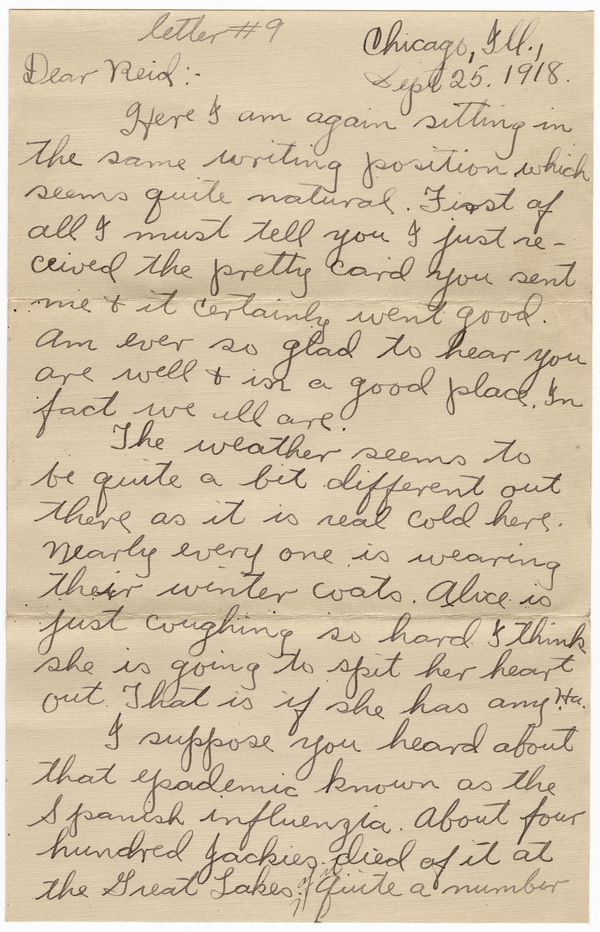
September 25, 1918, letter from Clara Wrasse to Reid Fields
(National World War I Museum and Memorial)
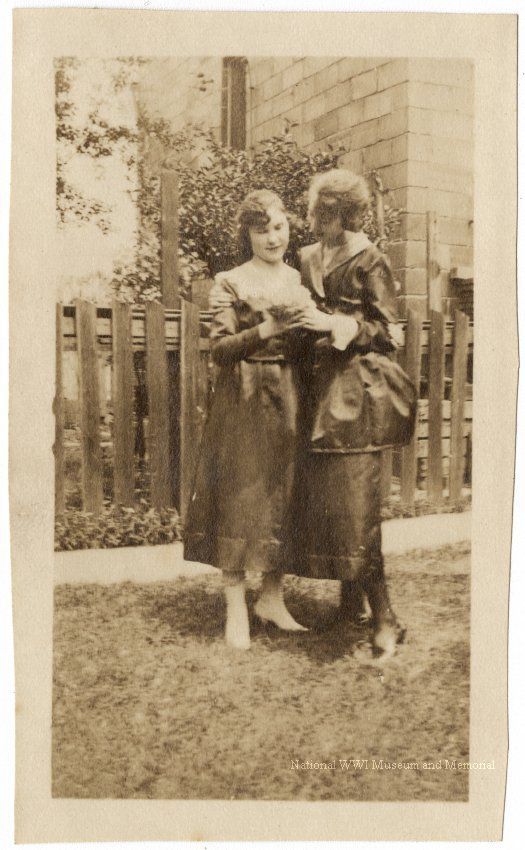
Wrasse is believed to be one of the two women pictured here.
(Courtesy of the National World War I Museum)
Signing off with the lines “hoping you feel as happy as you did when we played Bunco together,” Wrasse added one last postscript: “Any time you haven’t got anything to do, drop me a few lines, as I watch for a letter from you like a cat watches a mouse.”
Vogt of the National World War I Museum cites Wrasse’s letters as some of her favorites in the Kansas City museum’s collections.
“It’s so clear how similar across the ages teenagers are and what interests them,” she says, “and that … they’re kind of wooing each other in these letters in a way that a teenager would.”
Leo Baekeland
From the Smithsonian’s National Museum of American History

Leo Baekeland, inventor of the first commercialized plastic
(Public domain via Wikimedia Commons)
Inventor Leo Baekeland, creator of the world’s first commercialized plastic, “documented his life prolifically” in diaries, laboratory notebooks, photographs and correspondence, according to the museum’s archives center, which houses 49 boxes of the inventor’s papers.
Baekeland’s fall 1918 journal offers succinct summaries of how the epidemic affected his loved ones. On October 24, he reported that a friend named Albert was sick with influenza; by November 3, Albert and his children were “better and out of bed, but now [his] wife is sick with pneumonia.” On November 10, the inventor simply stated, “Albert’s wife is dead”—a to-the-point message he echoed one week later, when he wrote that his maid, Katie, was “buried this morning.”
Perhaps the most expressive sentiment found among Baekeland’s entries: “From five who had influenza, two deaths!”
Dorman B.E. Kent
From the Vermont Historical Society

Dorman B.E. Kent’s diary
(Courtesy of the Vermont Historical Society)
From the age of 11 to his death at 75 in 1951, Dorman B.E. Kent recorded his life in diaries and letters. These papers—now held by the Vermont Historical Society, where Kent served as a librarian for 11 years—document everything from his childhood chores to his views on Franklin Delano Roosevelt’s New Deal and his sons’ career progress.
Of particular interest is Kent’s fall 1918 diary, which contains vivid descriptions of his own bout with influenza. On September 24, he wrote (as mentioned above):
Awoke at 7:00 [a.m.] sick, sick, sick. Didn’t get up or try to. Had a high fever an awful headache every minute all day and was sick to my stomach also. Tried to get Dr. Watson in the morning but he couldn’t come. Told us instead what to do. Greased cloths with inflamacene all day and put around throat and chest and held a bottle of hot water at throat most of the time. Took a seidlitz powder about 10.00 and threw it up soon so then took two tablespoons of castor oil. Then the movements began and I spent a good part of the time at the seat … There is a tremendous lot of influenza in town.
Kent recovered within a few days, but by the time he was able to resume normal activities, his two sons had come down with the flu. Luckily, all three survived the illness.
In early October, Kent participated in a door-to-door census count of the disease’s toll. Surveying two wards in Montpelier on October 2, he and his fellow volunteers recorded 1,237 sick in bed, 1,876 “either ill or recovered,” and 8 dead in one night. The following day, Kent reported that “25 have died in Barre today & the conditions are getting worse all the while. … Terrible times.”
Donald McKinney Wallace
From the Wright State University Special Collections and Archives
Partially transcribed by Lisa Powell of Dayton Daily News
Donald McKinney Wallace, a farmer from New Carlisle, Ohio, was serving in the U.S. Army when the 1918 pandemic broke out. The soldier’s wartime diary detailed conditions in his unit’s sick bay—and the Army’s response to the crisis. On September 30, Wallace wrote:
Layed in our sick ward all day but am no better, had a fever all day. This evening the Doctor had some beef broth brought down to us which was the first I had eaten since last Fri. Our ward was fenced off from rest of the barrack by hanging blankets over a wire which they stretched clear across the ceiling.
On October 4, the still-ailing farmer added, “Not a bit well yet but anything is better than going over to the hospital. 2 men over there have Spanish Influenza bad and are not expected to live. We washed all windows and floors with creoline solution tonight.”

Donald McKinney Wallace’s September 30, 1918, diary entry
(Wright State University Special Collections and Archives)
Wallace survived his illness (and the war), dying in 1975 at age 78.
Though Wallace’s writings don’t reference the situation in his hometown, Bristow notes that many soldiers expressed concern for their families in correspondence sent from the front.
“You get these letters from soldiers who are so worried about their families at home,” she says, “and it’s not what anyone had expected. Their job was to go off soldiering, and the family would worry about them. And now, suddenly, the tables are turned, and it’s really unsettling.”
Helen Viola Jackson Kent
From Utah State University’s Digital History Collections
When Helen Viola Jackson Kent’s children donated her journals to Utah State University, they offered an apt description of the purpose these papers served. Like many diary writers, Kent used her journal to “reflect her daily life, her comings and goings, her thoughts, her wishes, her joys, and her disappointments.”
On November 1, 1918, the lifelong Utah resident wrote that she “[h]ad a bad head ache all day and did not accomplish much. Felt very uneasy as I found out I was exposed to the ‘flu’ Wed. at the store.”
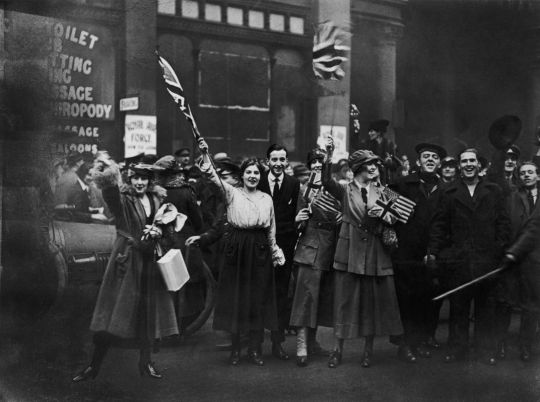
Armistice Day celebrations inadvertently spread influenza.
(Photo by Topical Press Agency / Getty Images)
Kent escaped the flu, but her husband, Melvin—called “Mell” in her diary—was not so lucky. Still, Melvin managed to make a full recovery, and on November 18, his wife reported:
Mell much better and dressed today. Almost worn out with worry and loss of sleep. So much sickness and death this week, but one great ray of light and hope on the outcome of the war as peace came this past [11th].
Interestingly, Kent also noted that the celebrations held to mark the end of World War I had sparked an inadvertent uptick in illness.
“On account of the rejoicing and celebrating,” she wrote, “this disease of influenza increased everywhere.”
#Nature
1 note
·
View note
Text
Ancestors: The Humankind Odyssey Review Roundup -- What Are The Critics Saying?
New Post has been published on https://gamerszone.tn/ancestors-the-humankind-odyssey-review-roundup-what-are-the-critics-saying/
Ancestors: The Humankind Odyssey Review Roundup -- What Are The Critics Saying?


We’re certainly not short on new game releases this week, and the reviews for many of these games are already beginning to roll on in. One, Ancestors: The Humankind Odyssey, is seeing a bit of an indecisive divide, with some outlets praising the survival game while others haven’t been as positive.
In Ancestors, you take control of a clan of apes in 10 million BC Africa and you must try and survive long enough for your lineage to endure until 2 million BC. You do this by eating, drinking, sleeping, reproducing, making mistakes, experimenting, and learning long enough until you can evolve and pass what you’ve acquired onto the next generation. The process is slow and dangerous, with both physical ailments and hungry predators repeatedly getting in your way.
You need a javascript enabled browser to watch videos.
Click To Unmute
Gamespot Live – Ancestors: The Human Odyssey
Size:
Want us to remember this setting for all your devices?
Sign up or Sign in now!
Please use a html5 video capable browser to watch videos.
This video has an invalid file format.
Sorry, but you can’t access this content!
Please enter your date of birth to view this video
By clicking ‘enter’, you agree to GameSpot’s Terms of Use and Privacy Policy
enter
Ancestors: The Humankind Odyssey launches for PC via the Epic Games Store on August 26. The game is also scheduled to release for Xbox One and PS4 in December. Below, we’ve compiled a list of some of the reviews that have already gone live for Ancestors, including our own. For a wider look at Ancestors’ critical reception, visit GameSpot’s sister site Metacritic.
Game: Ancestors: The Humankind Odyssey
Developer: Panache Digital Games
Platform: PC, Xbox One, PS4
Release Date: August 27 (December on consoles)
Price: $40 USD
GameSpot — 4/10
“Ancestors: The Humankind Odyssey lingers for far too long on its most toilsome aspects. The game does reward initial experimentation, but then asks you to repeat processes over and over again without any means of securing your legacy. It’s an absolute grind to reach the closest that Ancestors has to an endgame goal–survive for eight million years–and one costly mistake, whether the game’s or your own, can erase everything you’ve accomplished. What small satisfaction the game does provide is consistently ruined by violent predators, though the threat does lessen once you make it far enough into the neurological network’s expansive skill and perk tree. But as it stands, investing in Ancestors’ journey demands too much effort for too little reward.” — Jordan Ramée [Full review]
PC Gamer — 5.8/10
“Alas, the lineage of the Chunky Monkeys were wiped out about million years later after losing a few fights and running out of fertile females, and my next two clans didn’t fare much better. Starting Ancestors over again from the beginning is a major drag, having to re-discover every leaf and plant I’ve already long since grown tired of gathering, sniffing, and tasting—not to mention repeating all those endless, ulterior backrubs. I haven’t completed Ancestors yet, but I’ve definitely had enough of it.” — Christopher Livingston [Full review]
Rock, Paper, Shotgun — No Score
“I wrote most of this review, then felt maybe I was being too harsh. So I took a break and went back. I wanted to enjoy it. This time I’d play slower, explore a bit, find new foods, new tools and places. For a while I did that, and thought: maybe this is just a game that rewards people with more patience. But it was not long before I was being devoured by a forest lion because of the crap dodge mechanic. That ape was the last primateperson of my lineage, and although I could continue by going back to the main menu and trying again from a checkpoint, I decided to let the future human race die out. In many ways, it was a relief to be so thoroughly digested. Thank you, big cat. You can keep this jungle, I don’t want it.” — Brendan Caldwell [Full review]
Polygon — No Score
“Trying to break down Ancestors’ many systems would be a mighty task for a review, and to be honest, I don’t understand enough of them to try, even with about 10 hours’ worth of play under my belt. The strongest motivation I found to try new things was boredom — and I mean that in a flattering way. I could stay near my clan, and eat and drink and sleep as a contented hominid for as long as I’d like, but why would you play any kind of game if you didn’t want to go on an adventure?” — Ben Kuchera [Full review]
VG247 — No Score
“Ancestors feels wilfully stubborn. Even after developing my memory neurons, form recognition and sense of smell, my avatar was still forgetting what a dead branch looked like every 50 feet, or the sound of a hissing snake. It doesn’t really feel like it’s about evolution at all, as each generation only remembers the skills you’ve reinforced and will forget the rest, which means you need to repeat the same actions for millions of in-game years. There is a direction of sorts – expand and evolve – but the lack of colour, repetitive noises and actions all blend into one. It’s initially interesting, but its bundle of ideas and systems stumble between clever and stupid, intuitive and clunky. Ancestors: The Humankind Odyssey needs more time to evolve.” — Lauren Aitken [Full review]
IGN — 7/10
“Ancestors: The Humankind Odyssey’s greatest challenge is working out – or simply Googling – how its basic survival, crafting, and combat mechanics work. Once you understand them they become mostly trivial, and the main appeal becomes appreciating the exploration of the huge and lush prehistoric African map. Evolving your tribe’s abilities feels artificially drawn out, but it’s hard not to develop a soft spot for these disposable apes because of their authentic animations.” — Dan Stapleton [Full review]
Source : Gamesport
0 notes
Text
“Knights” Binding
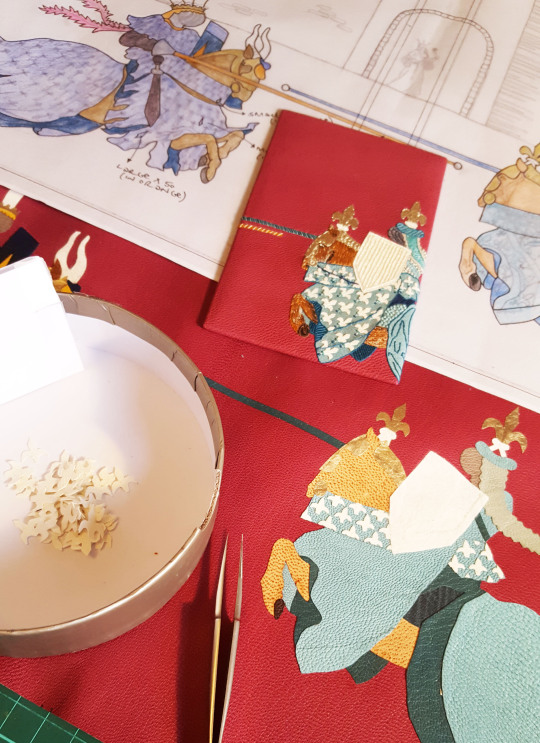
Sorry for the blog silence, I've just moved house (no mean feat with two under twos!) and I am now living in Bristol. This is a stop gap on our way into Somerset and country life, we have downsized and therefore my studio is temporarily residing in a storage unit down the road.
I am taking an enforced break from the physical act of bookbinding in order to take care of Ivy and Winnie (however it is impossible to switch my creative thoughts off during this time!) and I hope to take this opportunity to also catch up with the digital side of my life. For months I have been meaning to sort out my computer as have about a million baby photos to sort through, files duplicated numerous times and/or in the wrong order, photo editing to do for my website as well as numerous other onerous tasks.

I am also due to take on a new role come September, I will be the Project and Events Manager (PEM) for Designer Bookbinders so want my files to be in order before then. The PEM is the switchboard for information coming in from DB members and going out to the public. I therefore need to be completely up-to-date with all DB and other select bookbinding-related activities including dates for meetings, workshops, fairs and competitions. I will be responsible for publicising the above whilst trying to gain a stronger international presence for the society - watch this space for further updates on the role once I get started!
Before moving I managed to complete two bindings, it was great to draw a line under these before packing up my workshop. These were two books that unfortunately got delayed by my two pregnancies and although were started many (many) months ago laid dormant for quite a while. I am very thankful to my clients for being so patient and understanding during this time and was pleased to be able to hand over both in person before leaving London. The final task with regards both of these bindings is to write a blog post about each starting as follows...
The first of these bindings was an 1956 Allen Press publication of, “The Noble Knight Paris and Fair Vienne”. The book is a romance of thirteenth-century France which was regarded as the most popular story of medieval times.
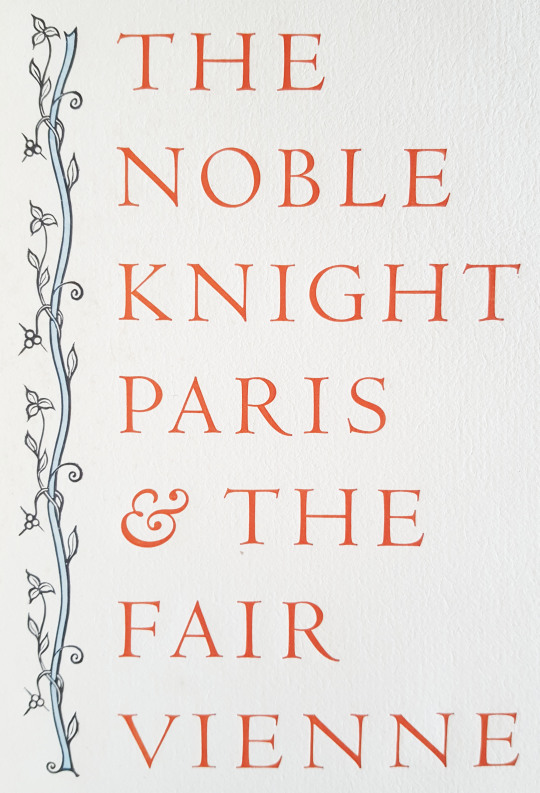
Inserted into the original book was a promotional leaflet about the publication from 1956, with details about the text block as follows:
_______________________________________________________________________
ANNOUNCING A NEW BOOK
The Noble Knight Paris and the Fair Vienne, Translated out of French by William Caxton
This edition, limited to 130 copies, has been produced by hand and is being published by the Allen Press, the private press of Lewis and Dorothy Allen, Kentfield, California.
The text of Paris and Vienne is a romance of thirteenth-century France, and was regarded as the most popular story of the middle ages. Although often copied in manuscript, and frequently printed in the fifteenth and sixteenth centuries, there are few romances so rare as this one. From the original Catalane language, it was translated into Latin, French, Flemish, Italian and English. A noted seventeenth-century critic stated that “it would be impossible to find a work more fitted to imbue the mind with correct taste and elegance of style, or to influence character by the wisdom of its reflections, or to forearm hearts against those assaults of fiery passion which blindly precipitate one into the abysses of misery. The work is truly admirable. The situations are so interesting and the dénoument is so happy, that their conception would reflect honor on the best writers of the most renowned ages.”
The only known copy of Caxton's printing (1485) is in the British Museum; the present edition is based on that copy.
The Allen Press is pleased to offer this important and delightful romance in a hand-made book of the finest materials and craftsmanship. The book was set by hand in the handsome Romanée types designed by Van Krimpen for the Enschedé foundry in Holland. The paper (printed damp) we believe to be the most distinguished sheet produced in modern times. It is named Val de Laga, and is from the Richard de Bas mill in France; this mill has provided hand-made paper continuously since 1326. When we wrote to the manager in Paris to question the high price, the reply was this, “Unfortunately, you have correctly heard the price of our fine paper. I do not know how expressing myself, but our old mill is not a 'commercial affair,' it is a 'thing of beauty' as said Keats, and our paper costs to us much than we sell it (we make only three hundred sheets a day!). That mill was founded in 1326 and we have no changed the process of fabrication. Every sheet costs much time: that is why it is dear and beautiful as not other one.”

The book was printed on Acorn-Smith handpress which was made in Philadelphia about 1830. On every page there are wood engravings by Mallette Dean; each (122 per book) has been hand-coloured by Dorothy Allen. There are approximately one hundred pages, 11 by 8 inches. The binding consists of an Invicta parchment spine, and sides of French paper decorated with wood engravings. The books are enclosed in slip-cases covered in the paper of the binding,
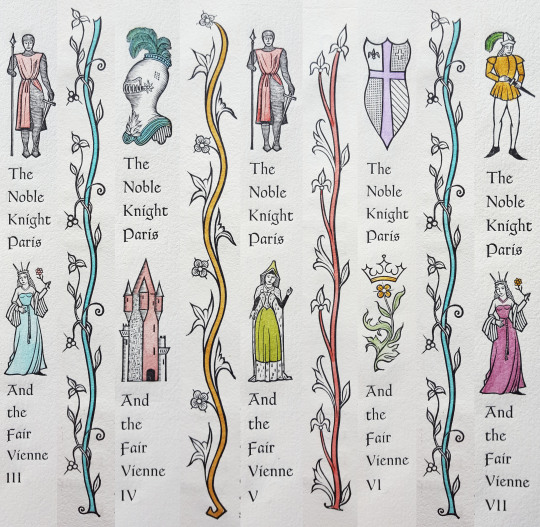
The publication date is May 15, 1956. On advance, PREPAID orders, a special price of $18.50 has been set. After May 15, the price will be $20.00. Because there are only 130 copies, we respectfully suggest that orders be mailed promptly.
The Allen Press 516 Woodland Road Kentfield California
_______________________________________________________________________
The book is a love story and I was taken by the idea of Paris the Knight jousting against his rivals for the admiration of Vienne. I thought that this would create a strong design and I could place the characters so that they would mirror well across the cover; Paris appearing on the front cover and his rival on the back with the jousting poles crossing the spine.

Quoted from the text, "Alle other knightes there were knowen by their armes, but the two white knights were unknowen...Said Vienne, yonder two white knightes that bear no armes on their sheldes are more to my fantasie".
Paris bore no arms on his shield therefore I decided to depict him with a plain white shield - in the story he goes on to win a crystal shield and a gold garland of flowers, presented to him by Vienne. On the cover design I drew her on the spine section - the same image as that taken from the wood block print in the text block. I placed her standing in the doorway to her castle, the castle being a much larger version of the wood block print that also features in the text block. The outline of this castle I planned to carbon or blind tool, with Vienne embroidered in colour.
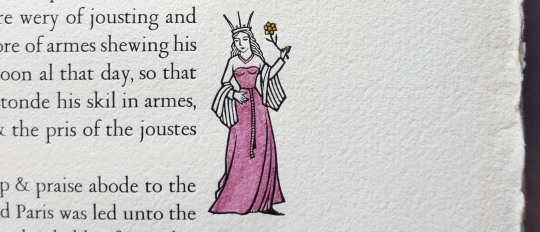
When it came to choosing the colour palette, the wood block prints in the text block were hand-coloured in pastel tones so I wanted this to follow through into the cover design. I had a lovely pink/purple Pergamena skin in my leather drawer that I chose to cover the book in and selected the leather onlays to go with this.
The woodblock prints were also my inspiration for the endpapers and doublures. I used the leaf and floral elements from the illustrated vines to carve some lino stamps, much larger than the originals.
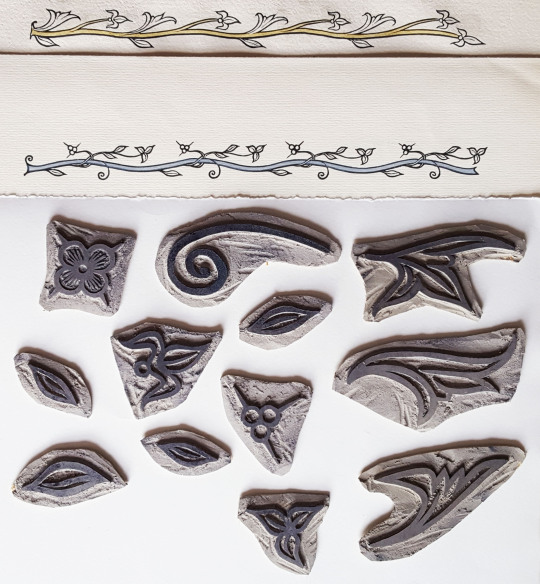
I didn’t originally have a vision about the pattern I was going to print these in so did some tests using an ink pad and some paper. It turned out that using all of the stamps together appeared too fussy so in the end I used just one to create a gridded repeat pattern. I felt that this worked better with the cover design, as the fabrics of the horses were repeat patterns too.
I used an oil-based ink, Intaglio Printmaker Black Litho/Relief Ink, for the printing. These inks are recommended for block printing but are slow drying so I had to do this a few days ahead of the forwarding.
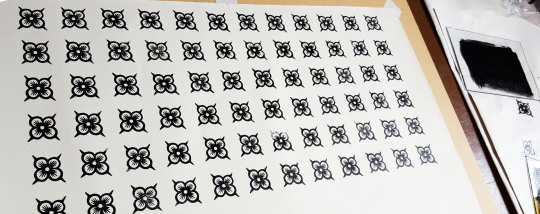
Given the leaflet that was included with the text block detailed the quality of paper used for the original binding I felt it important to get something as close as possible to that for the endpapers and doublures. I took one of the sections into Shepherds in London and found a very suitable match, both in weight and colour:
Ruscombe Mill 1840's Wove - 110gsm (RM184W11)
“This range was conceived to match European papers. These papers are available in 65 & 110 gsm and are made in both laid and wove versions. The papers are manufactured from cotton and flax, have four deckle edges and conform to archival standards.”
Once the ink was dry I punched out the centres of each of the flowers with my Japanese hole punch and stuck a circle of coloured paper, slightly larger in size, to the reverse of the hole with some PVA.
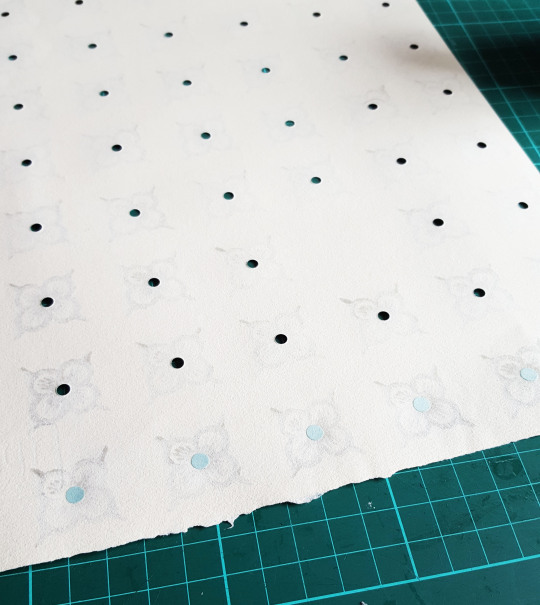
I also chose one flower on both the front and back doublures to back with gold leaf. Firstly I carefully pierced around the outline of the flower and then backed the hole with Moon Gold leaf that I had adhered to Japanese tissue in advance. This really caught the light and added a satisfying visual change in comparison to all the other black flowers.
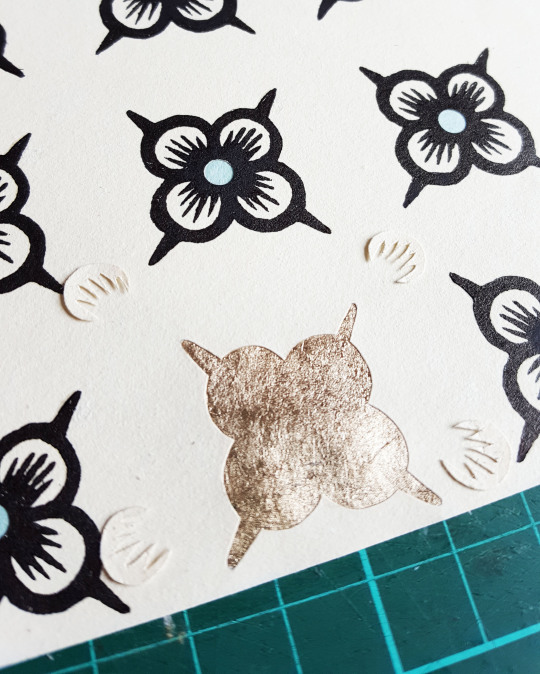
Once the endpapers were made up and sewn to the text block the book could be rounded and backed with a backing hammer. The spine was then lined with linen, leather and a hollow. The text block had deckled edges on the foredge and bottom of the pages which I kept but I sanded the top edge flat.
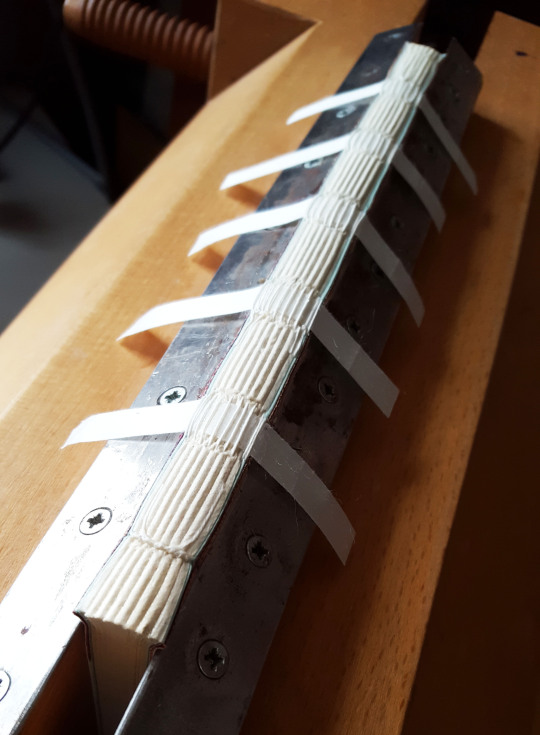
Once the book had been rounded and backed I sewed the endbands with colours to match the cover design and then laced on the boards. At this point it was possible to mark out the exact size of the book and cut the leather (yes, that is a newborn baby in the sling asleep whilst I work!).

As with all of my bindings I make a sample board ahead of working on the book leather to test out colours and stitches (this board comes in at number 50!). On a photocopy of the cover design I spent a while working out a colour chart for my onlays. Unless they really are too tiny to do anything with I rarely throw any of my leather scraps away so I have boxes of odds and ends to work with - perfect for a job such as this.

I first set about sticking onlays down onto the sample board leather. This included some alum-tawed leather for the white of the shield and fleur-de-lis on the cloak of the horse.

I also used some of the Moon Gold leaf I had stuck to Japanese paper for the head pieces of the knight and horse.

Once these were stuck down and the onlays back-pared I was able to start on the embroidery. I used a combination of different stitches to build up the design, pricking through the leather with a bodkin into some foam so I then knew where to place the stitches.

The embroidery stage of the binding is the bit I enjoy the most, in fact I find it quite therapeutic. It was also quite possible to achieve whilst sitting with a sleeping baby on my lap!
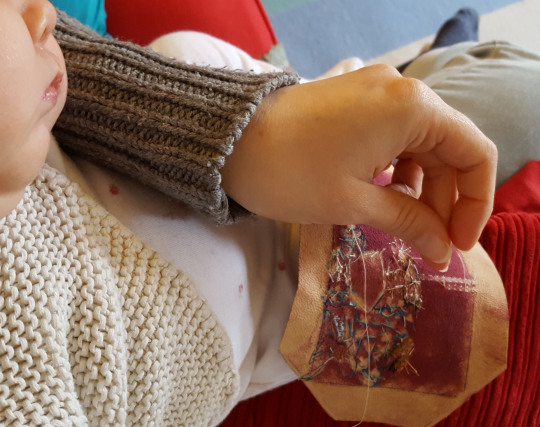
The white alum-tawed leather of the shield was given some texture with cross-hatched stitches in a thread of the same colour. I also built up the fur of the horse using small stitches in a variety of colours.

Once the embroidery was complete it was then time to stick it to the sample board. I always find it interesting to observe and capture the back of the piece before it goes onto the board/book as it will never be seen again!

It was then time to work on the leather for the actual book starting with glueing down the onlays. To ensure I get these in the correct place I work through a tracing paper template that I stick in place on top of the leather so it can be lifted up and down whilst adhering down the small leather pieces.

I worked on the larger block pieces first, building up the onlays layer by layer as I go trying to ensure there is not too much of an overlap between each piece.
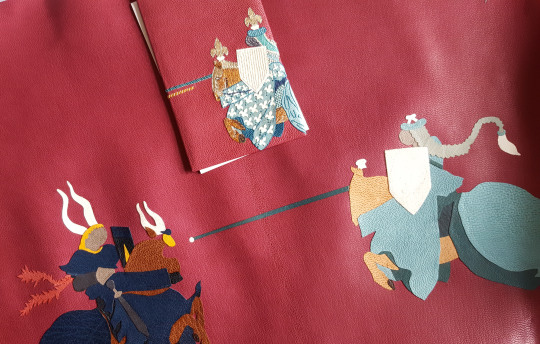
Once the larger pieces were down it was time to cut out and stick down the smaller onlays to make up the pattern of the outfit material of the horses and the knights.
Lots and lots of tiny onlays later.....

...the glueing was done and they were stuck down in place. I cut out three different sizes with the smallest glued at the top and the largest at the bottom.

And finally the onlays for Vienne were added to the spine.

The leather could then be pared. Firstly the edges were first run through a Brockman down to 0.4mm and then the “step” was taken off using a French paring knife. The main body of the leather was then back-pared using the knife, ensuring I vacuumed away the leather dust at regular intervals so as not to get any trapped under the leather leading to thinner patches being pared in the wrong places.

The joints of the leather where the boards were to hinge were sanded over a rounded edge to remove some of the thickness. It was then further pared in these areas when flat with my French paring knife to graduate the thickness.

I find it quite satisfying when you start to see a sort of “halo” image from the front coming through on the reverse of the leather in amongst all of the leather dust - this was the final result!
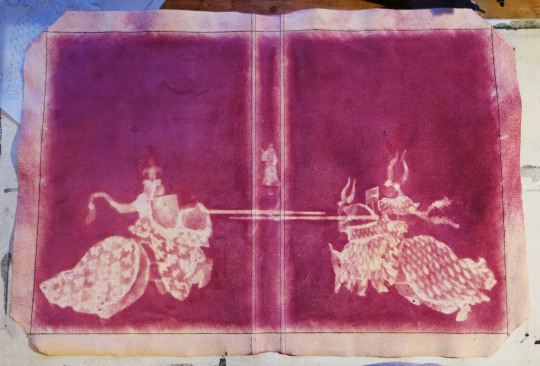
Along with my little “helper”, Winnie, the embroidery of the leather then commenced. I try and work on the outlines first and then build up the detail second, working through colour by colour. In order to access the part of the leather that I am embroidering I coil up the leather and fix it into a tube with bulldog clips at each end. The leather is too thick to use an embroidery hoop with but I find this works well and makes it more manageable.

Further to how I did the shield on the sample board I added French knots to the cross-hatching on the book cover to add a bit more textural detail. One of the main reasons I do a sample board is to help to visualise what the book is going to look like and I often embellish the actual book leather further than than of the board.

French knots and linear stitches were also added to the diamonds on horse number one.

Yet again, the back shows the random nature of the stitches in comparison to the front - how the thread passed its way around in order to create the cover detail. This will be forever concealed once the leather is on the binding...
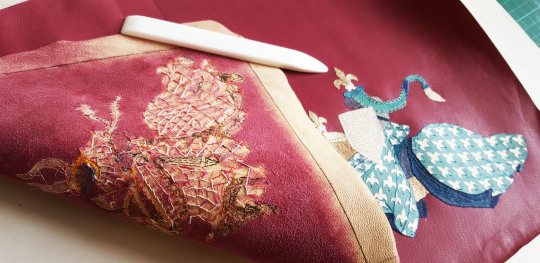
It is always a satisfying feeling to have finished the embroidery but then a slight feeling of trepidation steps in having to get it onto the binding!
The completed embroidery on the front:

The completed embroidery on the back:
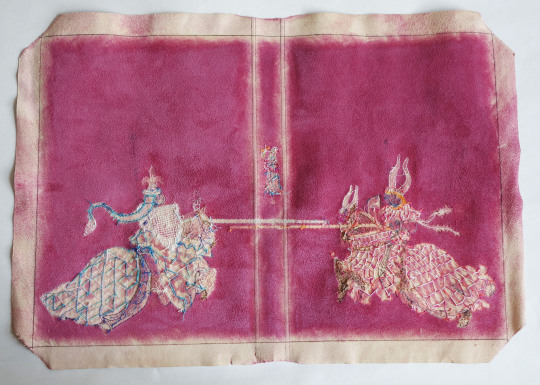
The book was then covered with the leather - definitely a stage of the process when I made sure the baby was elsewhere so as not to be disturbed during this crucial time! I dampened the front of the leather using a water spray before pasting out the back three times with paste. After covering I waited for it to dry for a good 24 hours before putting the leather joints down.

I then moved onto the tooling of the binding. The castle outline was first blind-tooled with pallets before filling in the lines with carbon. I used hand-made finishing tools to blind tool some texture beneath the horses and knights. These hand-tools often make an appearance in my bindings and have been a very useful little set to have made.
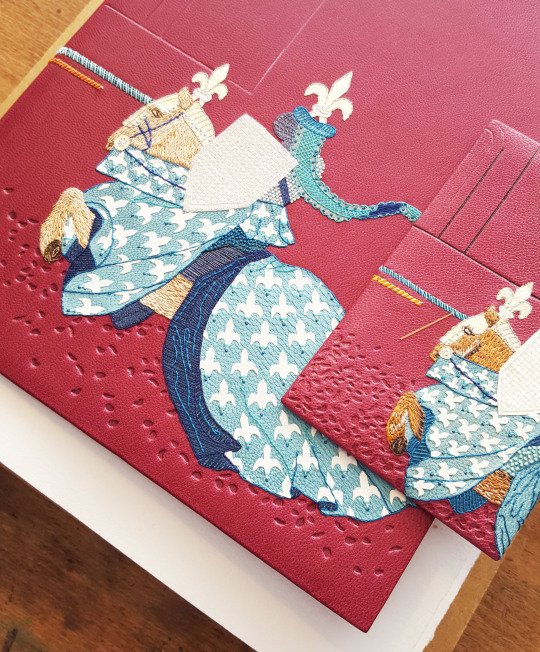
I was very pleased with how this tooling worked out, adding a visual difference to the bottom half of the leather, as shown in detail below.
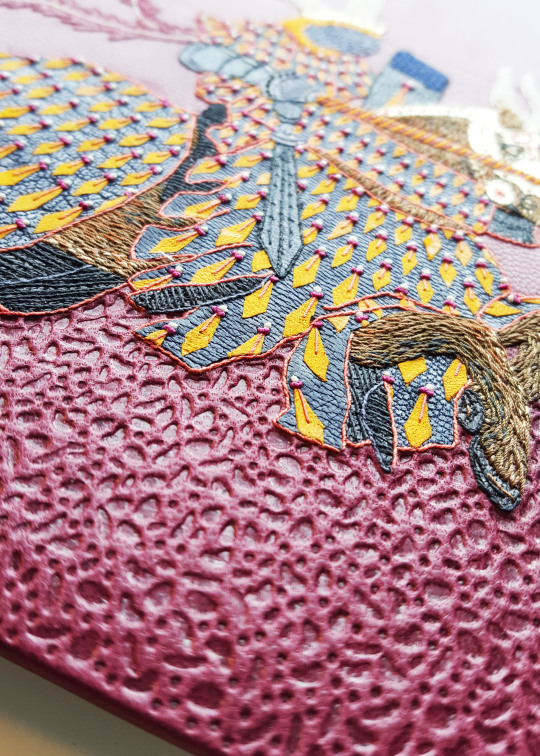
A small amount of Moon Gold was also tooled onto the fleur-de-lis of the Noble Knight Paris’ horse.

And then the book was held in a finishing press in order to tool the spine.
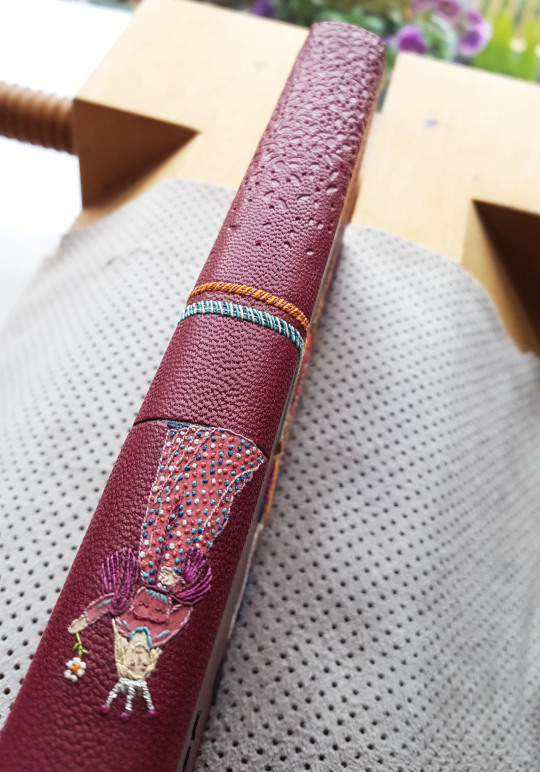
I had visions of the box of this binding ahead of working on it. A number of years ago I bought some planks of ebony, I think they were actually being sold for instrument making. I thought that the rich, dark colour of the ebony would work really well as the container of this binding so dug it out. The planks I had weren’t quite wide enough to make a solid lid so the panels were “book-matched”:
“Bookmatching is the practice of matching two (or more) wood or stone surfaces, so that two adjoining surfaces mirror each other, giving the impression of an opened book. As applied to wood, bookmatching is usually done with veneer (produced in one of several ways), but can also be done with solid wood”. Wikipedia
I wanted to carry over the fleur-de-lis pattern from the cover design onto the box and decided a good way of doing this would be to get a series of these laser-cut. I know a wonderful jeweller called Emily Kidson who uses Formica laminate in her work. She gave me some pieces a while back to try out and this seemed a perfect opportunity to have a go with it. I also had some wood veneers in my drawers so had some cut in this too.

I was really pleased with how the laminate fleur-de-lis looked when I got them back and set about working on how to place them on the box lid.

I also wanted to include one gold-plated fleur-de-lis so pierced the same shape from brass sheet. I then soldered some posts to the back of it so it could be physically fixed into the box lid.
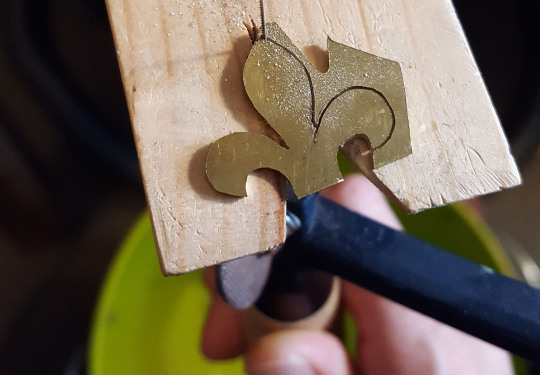
As well as the fleur-de-lis I want the jousting poles of the knights to be made from metal. I rounded the ends of some brass rod with a file, then removed the file marks with wet-and-dry paper before cutting the rod down. I then soldered these ends onto some posts - the smaller of the three circles was for the sample board.

I then had all these metal pieces polished and plated with 2 microns of gold.
The ebony was finished with Danish Oil and then a layer of bees wax. Under where each of the fleur-de-lis were to be placed on the lid I drilled some holes and pushed through brass pins.
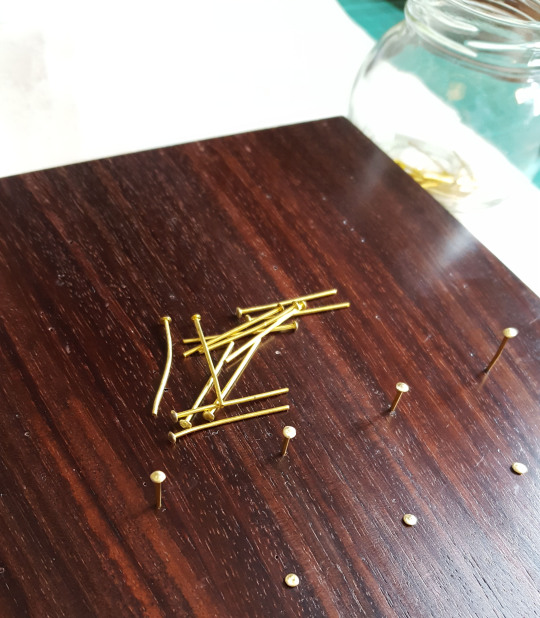
The heads of which were wound with a length of thread to add some detail with the ends of the threads being glued in place inside the lid.
Because the box had been oiled and waxed, I needed to abrade behind where they were due to be stuck down in order for the glue to have something to bind to. I cut out a paper template of the fleur-de-lis and used this through which to score the wood with the end of a scalpel blade.

The laminate fleur-de-lis could then be stuck down with PVA, a few at a time, and a weight placed on top of the whilst the glue dried.
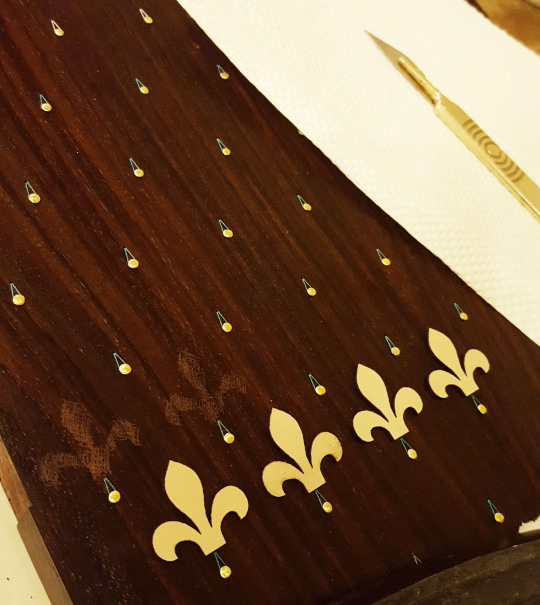
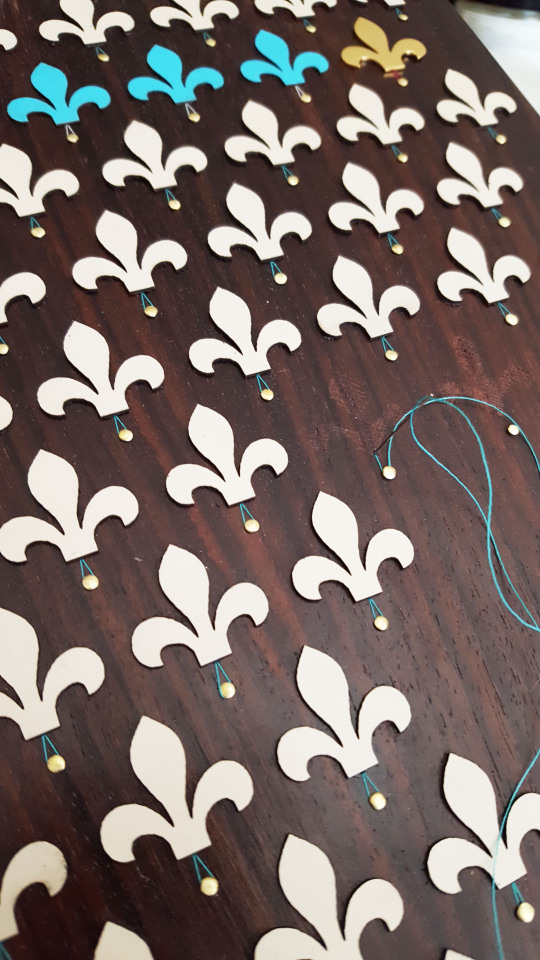
As a change from shop-bought catches, for this particular box I wanted to add an additional element in the form of a jousting stick to act as a clasp. I first covered some thin brass tube with Japanese paper using Lascaux Acrylic Adhesive. This glue is extremely elastic with the dry film remaining permanently tacky. It is great for adhering paper to non-porous surfaces such as metal so was perfect for the job.

Once there was a layer of Japanese paper adhered to the brass I had a suitable surface upon which to stick a leather layer to it. I first wound a strip of turquoise leather along the length with PVA and then stuck a thinner strip of purple leather on top of this around the join along the whole length.
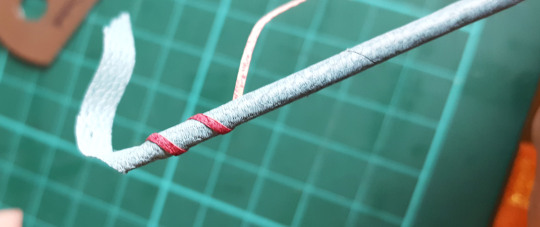
I stuck a bead on the tail end and had the “handle” end machined to my dimensions. Each of these two ends had a pin attached to it that was glued inside the brass rod. The jousting stick then had to have an tubular attachment made to be fixed to the box for it to feed through and close the container.
This was made by soldering some flat sheet to some brass tube, the inner diameter of which fitted the end of the turned brass jousting pole handle. This was then cut in two and one half of each drilled and pinned into a chiselled groove on the top/bottom of the box. When the lid was closed they married up and the jousting pole could be slid through it therefore holding the box closed. A second tube of the same specification was added a bit further down for the beaded end of the pole to sit in. These pieces were also covered in thin leather.

The box was hinged and then lined with felt, mainly to protect the book, but also to conceal the pins and thread that were visible inside the lid of the box.
I have now made it common practice to order each of my bindings and accompanying wooden boxes a conservation grade box to be housed in. I order these from the Bodliean Library and label them so they can be identified on a book shelf. The letters for this outer box were cut from the title panel for the ebony box, therefore the offcuts weren’t wasted.
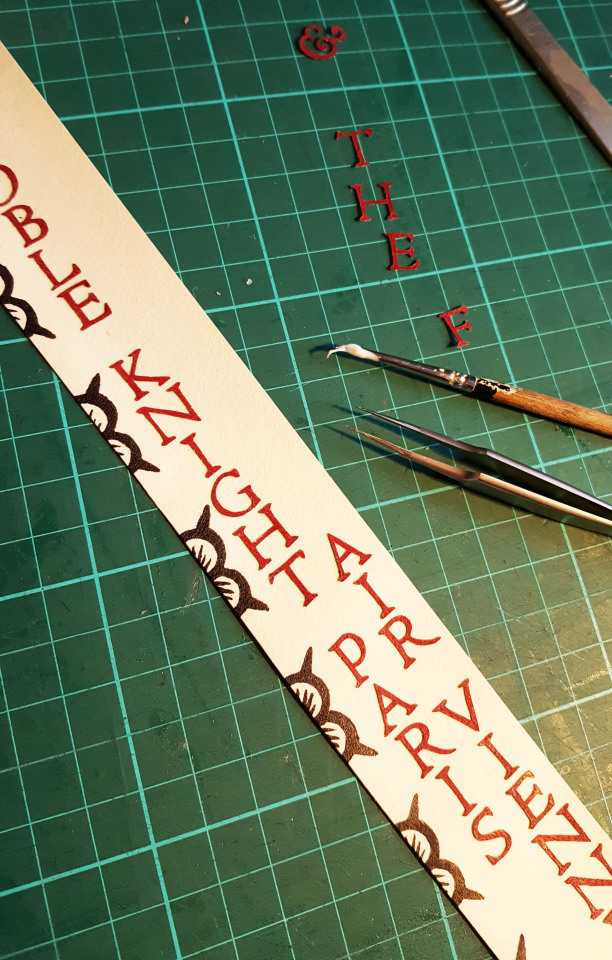
And so comes to an end the making of this binding! But not to the work surrounding it as I had to photograph and catalogue the book for my website.
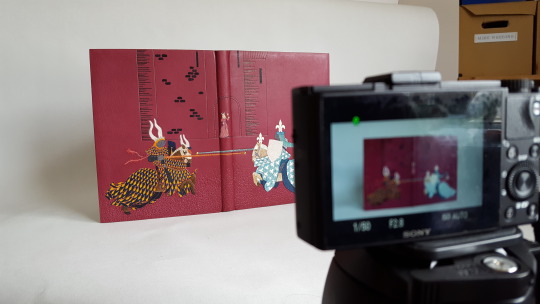
I have a new website in the making at present by my husband George therefore this will be one of the last to appear on my existing site. With that however comes a lot of work as I assess what from my old site makes the cut to the new one.
I will also be amalgamating this blog onto it so I no longer have so many different platforms to publish things on! I will however have a bit of a cross over where my posts will appear simultaneously on both for a while until the change happens for good.
I will leave you with a few select photos of the final piece in all it’s glory, for more please visit my website.
FRONT COVER:
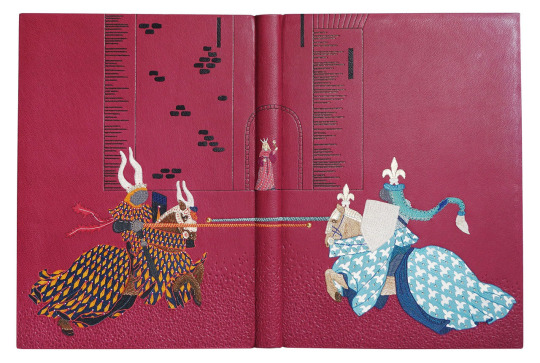
ENDPAPERS AND DOUBLURES
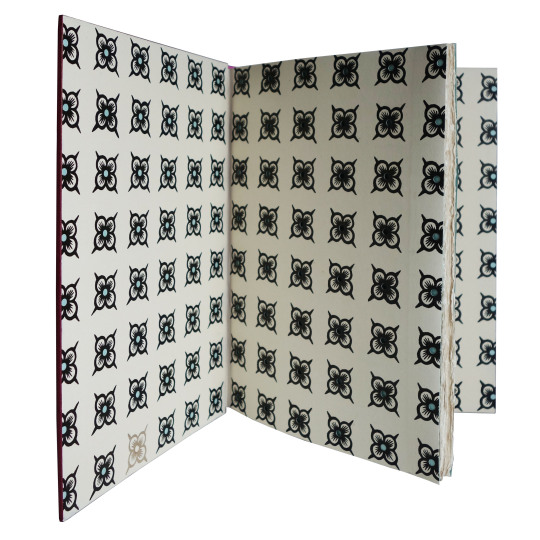
SPINE DETAIL OF VIENNE:
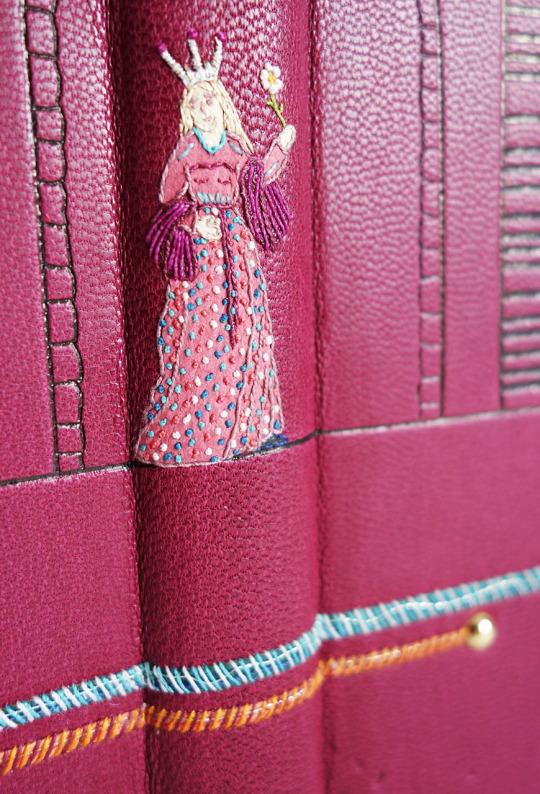
COVER DETAIL:
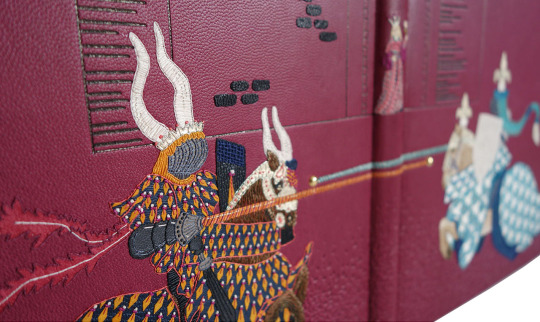
BOOK IN BOX:

On an end note, if you are interested in making your own “sample board” I am due to teach a class for the DB/SoB joint workshops in February next year in the beautiful Bradford-on-Avon, details can be found on both the DB and SoB websites over the coming weeks.
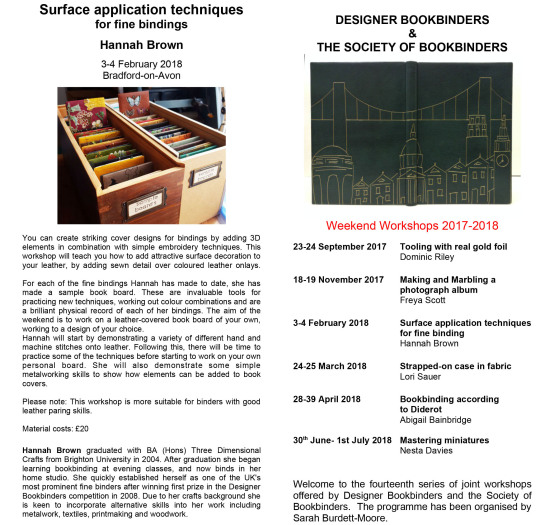
#bookbinding#designer bookbinders#society of bookbinders#embroidery#soldering#jousting knights#knights#jousting#leather#linoprint#shepherds#ebony#bookmatched#laminate#formica#teaching#sampleboard#paring#romance#printing
43 notes
·
View notes
Link
When you take a close look at the flowery but meticulous lettering in the 17th-century book, you can see that many people wrote the script, at different times. The book includes everything from sermons to poems, and there’s a dedication to Pope Urban IV.
The Libro de Sermones Varios en Lengua Quiche, from 1690, is the oldest manuscript in the collection of the Smithsonian’s National Anthropological Archives. It provides not only a fascinating look at the evolution of the Maya K’iche’ language, but it also tells a stark tale of religious history.
“When I see a document like this it just blows me away to see the care with which the language was put on paper by so many different people,” says Gabriela Pérez-Báez, curator of linguistics in the anthropology department at the National Museum of Natural History. She says the book is written in four different languages, including K’iche’, Latin, Spanish and Kaqchikel. “The paper is thicker, the book smells differently, it is really amazing to see the care with which it was written,” Pérez-Báez marvels.
The Libro de Sermones is part of the Objects of Wonder exhibition now on view at the National Museum of Natural History. The book has also been digitized so that scholars can peruse the book both to answer questions about history, but also to document the changes in the K’iche’ language as the Spanish were taking over the Maya empire (THERE WAS NO MAYA EMPIRE! COME ON SMITHSONIAN!) in the 16th century. The text in the Libro de Sermones is very similar to the K’iche’ language that was spoken before contact with the Spanish. The book was given to one Felipe Silva by Pablo Agurdia of Guatemala in 1907, and Silva apparently donated it to the Smithsonian Institution sometime after that, but there are no documents explaining exactly how that happened. Today, Pérez-Báez says the book is quite relevant and important to scholars.
“K’iche’ is a Mayan language which dates back several thousand years. It certainly precedes Spanish by hundreds of years. It is a language which is spoken in Guatemala, so Mayan languages are still in use across what is now Guatemalan Mexico and have spread as far as the Northern third of Mexico. But otherwise they are concentrated in Mesoamerica—the South of Mexico and in a little bit of Central America, Guatemala and so on,” Pérez-Báez says. “Languages change naturally, but they also change when they come into contact with other languages… . Once contact with a Colonial language becomes very intense … the influence of a language like Spanish on indigenous languages is greater and greater over time.”


















K’iche’ is spoken today by more than one million people, and thousands of K’iche’ speakers now live in the United States, according to Sergio Romero, a professor in the department of Spanish and Portuguese at the University of Texas at Austin.
“Lots of migrants, especially in the last two decades, are K’iche’ speakers. I am often called to translate on behalf of K’iche’ speakers who don’t speak Spanish,” Romero says, adding that K’iche’ is one of 33 different Mayan languages. “There are different dynamics to each of these 33 languages, and each of them has a lot of regional variation. So between K’iche’ and Ixil, another Mayan language, there is as much difference as between English and … Hindi.”
Romero says one of the reasons the Libro de Sermones is important, is that in the 19th century around the time of Guatemalan independence, K’iche’ lost its status as the official language in the region. But there are many documents including wills, land deeds and various sorts of chronicles and other texts written in K’iche’ from the 16th and 17th centuries. There are also pastoral texts, catechisms and confessionals used by priests to both learn the language and try to convert the K'iche.’
But Romero says the K’iche’ resisted being converted to Catholicism, and there is evidence of that in the book, which he says is a “crucial” tool in illustrating that fact.
“It’s the way in which the K’iche’ were able to cope with the Spanish invasion and the Christian invasion … . They didn’t assimilate,” he says. “What they did was appropriate certain elements of Spanish culture to be able to adapt and defend and protect their own spaces of political and cultural sovereignty. So K’iche’ religion today is really a hybrid religion that has elements of Spanish origin and elements of Christian origin and this document shows that very well. You can see how certain words were actually bent by the Spanish to be able to convey certain meanings and you can see how those certain words were interpreted in a different way by the K’iche.’”
Romero points to the word mak, which is used today to reference sin, as in Christian sin. But in the 15th century it meant ‘will,’ as in your will to do something. Sin, Romero says, didn’t exist as a concept to the K’iche’ because they were not Christian. Dominican missionaries took that particular word and shifted its meaning so it could be used to convey the theological notion of sin.
“The only way to resist was to adapt,” Romero says, “but the adaptation was not decided upon by the Spanish.”
He adds that even today, the Catholic hierarchy in Guatemala still cannot accept the fact that Christian practices among the K’iche’ are simply different than those of non-indigenous Catholics. Romero says the K’iche’ religion of today is the result of this “interesting dialogue” between Dominican missionaries who wanted to impose a certain brand of Catholicism and the K’iche’ who just picked whatever was interesting and useful to them.
The Smithsonian’s Pérez-Báez, who was raised as a Catholic in Mexico City, explains that even in an urban Spanish environment children are taught that one must be a good person, or they will burn in hell. She is not a K’iche’ expert, but Pérez-Báez thinks that the sermons in this book likely contain similar rhetoric that was used to coerce people into converting to Christianity.
To her, Libro de Sermones is a reminder of what she calls the brutally violent mandatory conversion to Catholicism. The Spanish colonization involved forced labor, and the Mayas who refused to give up their original religion were often jailed and tortured for heresy. Maya artifacts were deliberately destroyed, and most of their sacred texts were burned. Pérez-Báez says the book was likely produced by native speakers of K’iche’ whose original, indigenous names had already been replaced with Spanish names, who were being converted against their will.
“To me, being an advocate for linguistic diversity in this respect of human rights, it’s very difficult to hold a document that was an important part of the conversion to Christianity and all of the abuses. This book was representative of an era during which colonialism and the associated conversion to Christianity oppressed the indigenous population in often violent ways,” Pérez-Báez explains.
She is also disturbed by the thought that native speakers of K’iche’ were hired, or used, in the production of a book that was being used as an instrument to force the conversion of the remainder of the K’iche’ population.
“This is evidence of that conversion process that was very damaging to the languages, the cultures, the local knowledge, but especially the physical and emotional well-being of the people,” Pérez-Báez says.
Both she and Romero think the digitization of the Libro de Sermones is vitally important for scholars, even though the ancient text had to be laid nearly flat page by page to get a good digital image. Pérez-Báez says the book has gone through conservation, and is in pretty good shape for the Wonder exhibition. Allowing access to the document to scholars around the world is critical, Romero says. It also makes for better preservation.
“We’ve gotten to a different age in the study of colonial manuscripts of indigenous languages. … For us, having access to these manuscripts online is crucial because we need to have concordance between different text,” says Romero. He explains that sometimes a particular text doesn’t have the full story. That means scholars then have to consult different documents being reviewed by other colleagues that may include the missing fragments.
“Many libraries are actually digitizing their manuscripts and making them available online for scholars… . It allows us to work across political lines and borders… . So now we can use digital copies of manuscripts to be able to work together on the same text and that makes for a much more rich and interesting dialogue.”
#archaeology#arqueologia#quiche#k'iche'#maya#mesoamerica#mexico#anthropology#antropologia#native american#indigenous
43 notes
·
View notes